- US Dollar
- Euro
- British Pound Sterling
- Canadian Dollar
- Australian Dollar
- Home
-
SHOP ECO FARM
- ECO Farm Grow Lights
- ECO Farm LED Grow Lights
- ECO Farm Quantum Board
- ECO Farm Samsung LED Grow Lights
- ECO Farm COB Grow Lights
- ECO Farm Commercial Lights
- ECO Farm Supplemental Grow Light
- ECO Farm Fluorescent grow lights
- ECO Farm HPS & MH Grow Lights
- ECO Farm CMH Grow Lights
- ECO Farm HID/CMH Bulbs & Ballasts
- ECO Farm Grow Tents & Kits
- ECO Farm 2x2ft Grow Kits
- ECO Farm 3x3ft Grow Kits
- ECO Farm 3.3x3.3ft Grow Kits
- ECO Farm 4x4ft Grow Kits
- ECO Farm 5x5ft Grow Kits
- ECO Farm Grow Tent - Standard Style
- ECO Farm Grow Tent - Extension & Roof & Lodge Style
- ECO Farm Extraction & Harvest
- ECO Farm Rosin Press Machine
- ECO Farm Dry & Wet Trimmers
- ECO Farm Oil Accessories
- ECO Farm Medicinal Plants Grinder
- ECO Farm Medicinal Plants Containers
- ECO Farm Medicinal Plants Dryer
- ECO Farm Refrigeration Dryer
- ECO Farm Climate Control & Other Accessories
- ECO Farm Inline Duct Fans
- ECO Farm Oscillating Fans
- ECO Farm Exhaust Fans
- ECO Farm Air Filter
- ECO Farm Duct Muffler
- ECO Farm Ventilation Kits
- ECO Farm Plant Humidifiers
- ECO Farm Plant Dehumidifiers
- ECO Farm Hydroponic Accessories
- ECO Farm Other Accessories
- ECO Farm Hydroponics Microscopes
-
TOP BRANDS
- Grow Lights Brands
- Adjust-A-Wing
- Apollo Horticulture
- Bestva
- Black Dog LED
- California Lightworks
- ChilLED Grow Light
- Eco Farm
- HLG - Horticulture Lighting Group
- Kingled
- Kind LED
- Mars Hydro
- Morsen
- Neilo
- NextLight
- Phlizon
- PlatinumLed
- Roleadro
- Optic LED Grow Lights
- ViparSpectra
- Vivosun
- EYE Hortilux
- IPOWER
- NanoLux
- Phantom grow light
- Gavita grow lights
- Grower's Choice
- Lumatek
- Maxibright
- Yearld Pro
- ThinkGrow
- Crecer Lighting
- Green Sunshine Electric Sky
- fohse aries
- loriflux
- luxx
- fluence
- iluminar
- Lex
- LTC
- Rayonled
- FGI
- PHOTONTEK
- Grow Tents & Kits Brands
- Apollo Horticulture
- Black Box
- CoolGrows
- Eco Farm
- GrowLab
- Gorilla Grow Tents
- Mars Hydro
- Quictent
- Secret Jardin
- Unit Farm
- TopoGrow
- VIVOSUN
- Topolite
-
COMPANY INFO
-
COOPERATE WITH US
- Blog
Top 3 Best 4 Inch Carbon Filters for a 3×3 Grow Tent (Updated 2021)
July 10, 2021
Grow rooms need good ventilation to keep cool, fresh air coming in, and warm, moist “used” air going out. But indoor growing can produce unwanted and even potentially toxic odors and contaminants from soils, fertilizers, and the plants themselves. Since the exhaust air often flows into an adjacent indoor area, adding activated carbon filters to your airflow system is the best way to control odors and contaminants.
How does a carbon filter work?
Every grow room or grow tent has air hovering around that produces a bad smell. Instead of this air escaping outside the grow room, it passes through a carbon filter that has activated charcoal. The work of the activated charcoal is to chemically absorb the odor from the air and allow clean air to circulate in the grow room. The activated charcoal contains little carbon molecules that are very efficient in absorbing weed odor and that of other different crops.
Good odorless air then comes out of the carbon filters exhaust and you can enjoy farming in a fresh clean grow room. To make the process even efficient, you need a fan to suck or push the air out. The majority of the carbon filters come fitted with inline fans, which are very effective in ventilating the room.
What Size Carbon Filter For 3×3 Grow Tent
Grow tent of 3×3 size falls in the category of mini tents suitable to grow 2–4 large or medium-sized plants. Here the internal area or volume is too small to hold big filters.
So, a carbon filter of 4-inch will do air cleaning and odor absorbing jobs efficiently in this 3×3 size tent.
However, if you are using high-pressure lights then it’s better to go for a 6-inch filter in this scenario. Otherwise, you may not be able to control heat.
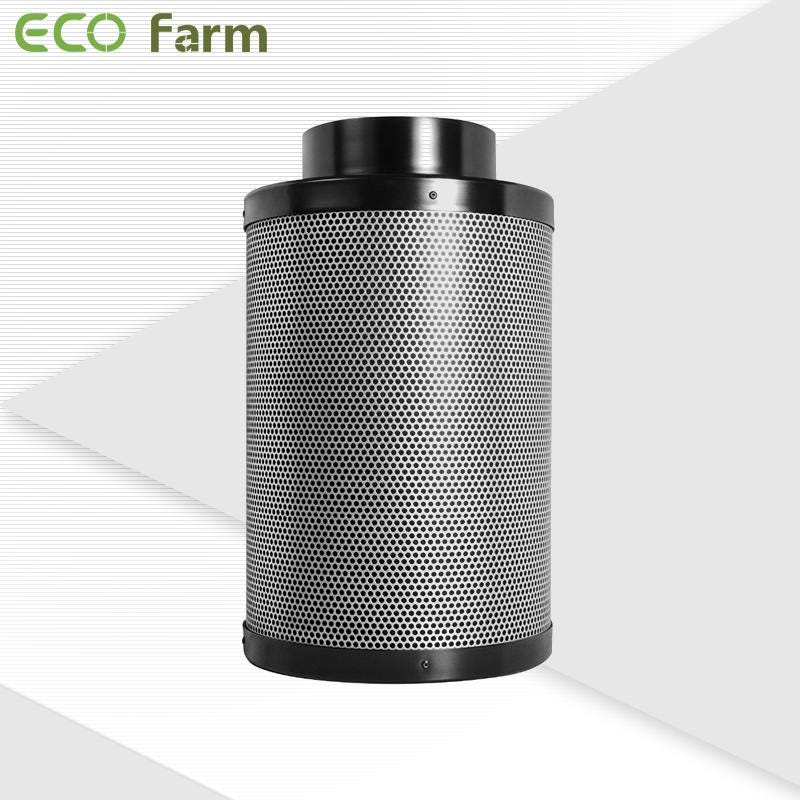
Features:
ECO Farm carbon filters are made with extreme quality materials and they are some of the most efficient in the market. The 4 inch is great especially for marijuana grow room farmers. The product also works well in any other place that does not have a celling or roof cavity to displace extracted air. Such places could be cabinets, cupboards, and lower level floors of storeys buildings. The product also works well in air-cooled lighting rooms and window-to-window applications. Made with superior quality carbon, the product comes fitted and has the ability to deliver 100% uninterrupted airflow.
The product has the ability to capture three times more air contaminants than average due to its optimal surface area per carbon particle. This quality product eliminates odor from the grow room and protects the crops from chemical irritants. The same product also works well to absorb bad odor in pet houses, kitchens, bathrooms, and basements among other places.
Vortex VTX400 220 CFM 4" Inline Fan and Pro-Lite Filter Carbon Filter
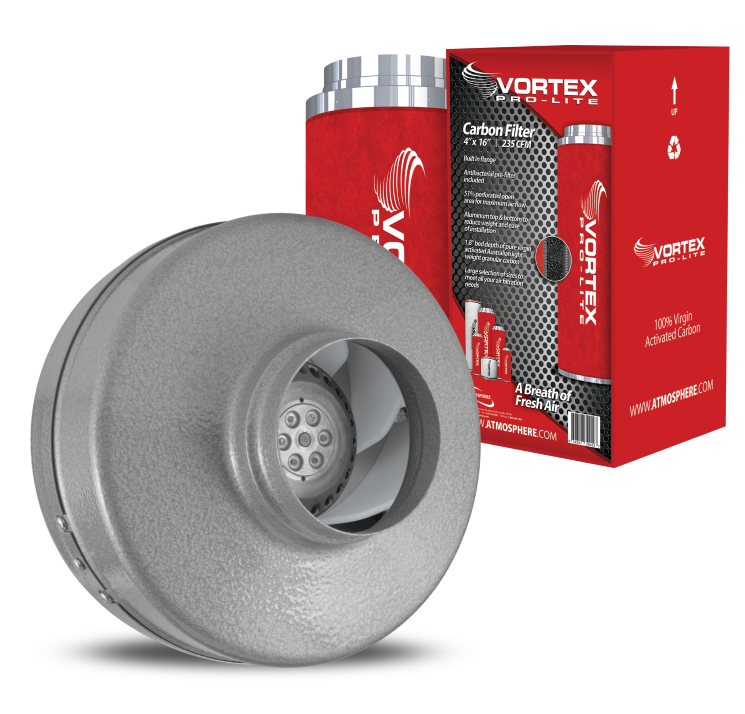
Features:
Manufactured with only the finest virgin RC-48 Australian activated carbon, the Pro-Lite filters effectively remove 99.5% of volatile organic compounds. The PreFilter eliminates bigger particles such as dust to prevent premature usage of carbon. Rated for continuous worry-free operation, lightweight, and compact dimensions, make the Pro-Lite filters ideal for your air filtration needs. It has an aluminum top and bottom to reduce weight and increase installation convenience. 51% of the perforated open area provides maximum airflow.
CoolGrows 4 inch Air Carbon Filter
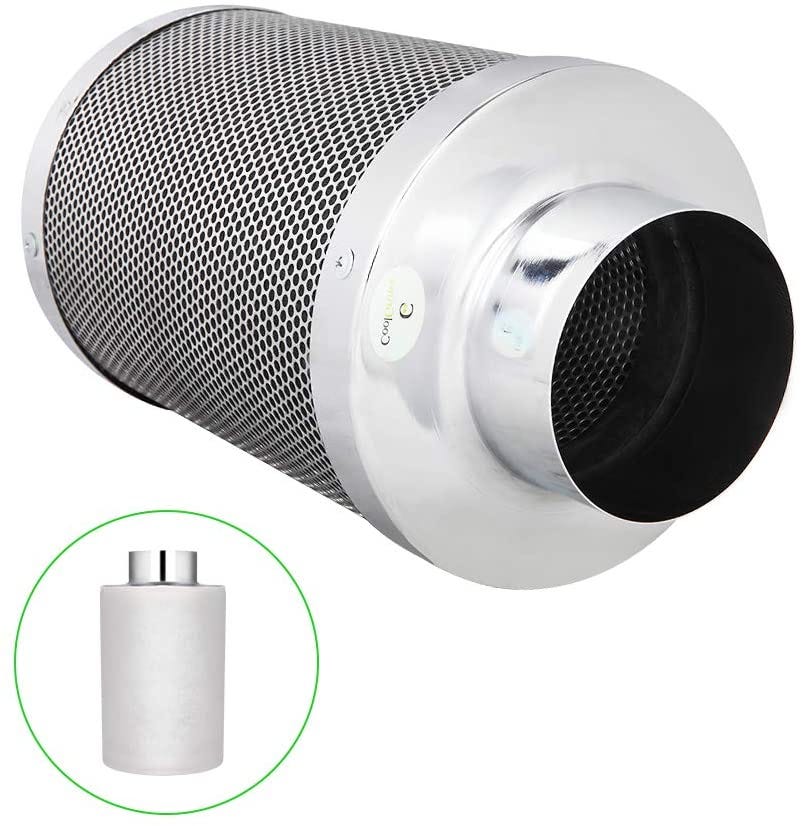
Features:
Bad odor is a turn-off in grow rooms and grow tents both for you and the crops. You can have the most efficient grow rooms by using CoolGrows products which are some of the best odor removers in the market. A carbon filter has all the abilities to remove bad smells from your grow room, and other rooms in your home.
It is a long-lasting product made with a sturdy aluminum galvanized body and a rest-resistant mesh made with high-quality iodized zinc. With the product, you can be sure of almost 100% of uninterrupted airflow and an increase of the surface area between the inner and outer mesh of the filter. This is because the carbon in the filter is machine-packed to give efficient results.
What to consider when choosing the best carbon filter for grow room
The market has tons of carbon filter options available in the market and it is therefore important that you choose the right one for effective results. The following factors will help you in choosing the best carbon filter for your grow room.
Material
The material of the carbon filter is one of the most important factors to consider when you are choosing your product. The majority of the filters have heavy-duty premium galvanized steel which ensures their durability and performance. Premium material is pricier than other materials but does not compromise quality by opting to buy less expensive carbon filters. Maintenance of good quality premium material is also easier compared to other materials.
Pre-Filters
The majority of the most quality carbon filters come readily packaged with pre-filters that you can use outside the carbon filters. The pre-filters play a big role in helping with the elimination of dust and other particles in the grow room. With these out of the way, the carbon filter and inline fan stay clean and work more efficiently. A pre-filter also increases the life span of a carbon filter.
Compactness And Portability
Noise is irritating and if you want a carbon filter with no or very little noise, buy one with compact carbon filters. These have less noise and vibration during their operations. Compact carbon filters also have a better odor and smell absorbent capabilities. Also, make sure you get a carbon filter that is easily portable in case you want to change its position in the grow room.
Thickness
The thicker the carbon is in the filter, the better the absorption abilities. Filters with more carbon thickness control odor better than those with less thickness do. they are very efficient and as such attract more costs. they are however worth every cent.
Size
The size of your grow room will also determine the size of the carbon filter you want to buy. Carbon filters come in five different sizes, which are 4-inches, 6-inches, 8-inches, 10 inches, and 12 inches. For small-scale marijuana farmers, a 4-inch carbon filter will do just fine. The majority of the carbon filters also come with manufacturers’ guarantees ranging from 3 months to 2 years depending on the size and brand.
Conclusion
Your best carbon filter for grow rooms needs a filter to stop odor from escaping and also to keep bugs out of the system. A carbon filter is the best choice since it’s reliable and relatively quiet. They are only as effective for indoor growing as the carbon in them, so when choosing a filter, go for the best carbon filter for the growing room, one that has high-quality activated charcoal and has plenty of it. Thicker carbon filter beds mean a longer lifespan and more effective odor control and filtration.
ECO Farm ECOM Bluspec 650W LED Grow Light with Samsung LM301B and Cree Chip VS Iluminar iLogic 8 630 Watt LED Grow Light
July 09, 2021
Are you looking for the best LED grow lights for indoor plants? Indoor gardening is a fun and exciting venture but it can get messy when you don’t invest in quality inputs. We all understand that grow rooms require light which facilitates the growth of plants in an artificial environment.
Many gardeners often experience challenges when it comes to selecting the best LED grow lights for indoor plants. There are hundreds of LED grow lights for sale in the market to choose from.
As a rule of thumb, you should always go for the best LED grow lights that are of high quality, energy efficient, and affordable.
What are LED Grow Lights?
There are various options for indoor garden lighting, but no others offer the energy efficiency and overall benefits to plant growth that LED grow lights can offer. LED lighting wasn’t a viable option for indoor gardening until after 2014, when scientists finally developed a blue-spectrum LED. Until then indoor growers traditionally relied on two types of HID bulbs, High-Pressure Sodium (HPS) and Metal Halide (MH), which offered the necessary light for flowering and vegetative growth, respectively.
What are the benefits of LED grow lights?
LED grow lights have proven to be the perfect choice for many gardeners due to their energy efficiency and lifespan.
Other additional benefits that comes with LED grow lights bulbs are;
They are smaller and they occupy less space
Less light intensity loss
Although LED grow lights have been proven to be of premium quality, different grow rooms have different light requirements. Therefore, it is important to have the following factors in mind so that you can be in a better position to select the best LED grow lights that suits your grow room requirements.
ECO Farm ECOM Bluspec 650W LED Grow Light with Samsung LM301B and Cree Chip
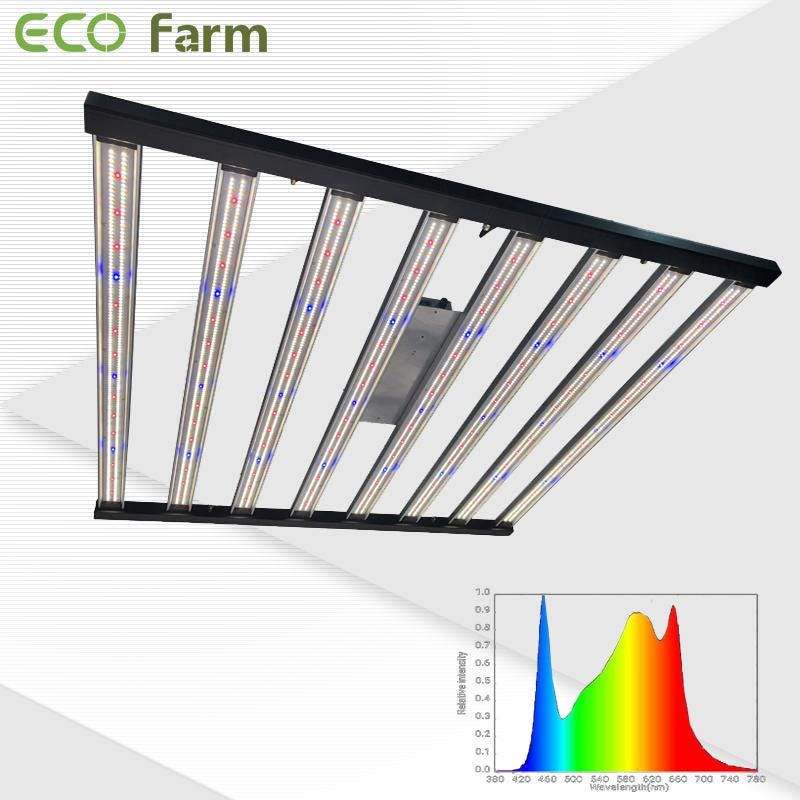
Features:
The ECO Farm grow light is equipped with Samsung LM301B and Cree Chip to ensure high-efficiency PPE 2.7umol/J, better heat dissipation, and long service life. Compared with old plant lights, the average PPFD is increased by 30%, and the yield and quality are increased by 50%. The most effective plant growth spectrum, better than HPS, MH, CMH, Inducton and Fluorescent in the same power test. An ideal spectrum suitable for vegetables and flowering stage. UV and IR can be controlled separately. UVIight maximizes the yield of trichomes and makes plants more resistant to pests and diseases. In this case, if an experienced grower uses it at the beginning of flowering, IR will induce the plant to bloom and increase the number of flowers. Using it during the last two weeks of the flowering period, ultraviolet light will increase the THC content in the plant. Finally, it is a fanless and zero-noise design, which is very quiet.
Efficacy:2.7umol/J
AC Input Power:650W
PPF:1715 umol/s
Grams Per Watt: up to 2.0
Lifetime: >50,000
Weight: 15kg
Coverage Footprint:
Veg: 4' x 4' area (Up to 7' x 7' area)
Flower: 4' x 4' area (1.2m x 1.2m)
Max: 5' x 5' area (1.5m x 1.5m)
Hanging Height : Flower: 6"-24"
Recommended for: Grow Tents, Grow Rooms, Commercial Grows.
Iluminar iLogic 8 630 Watt LED Grow Light
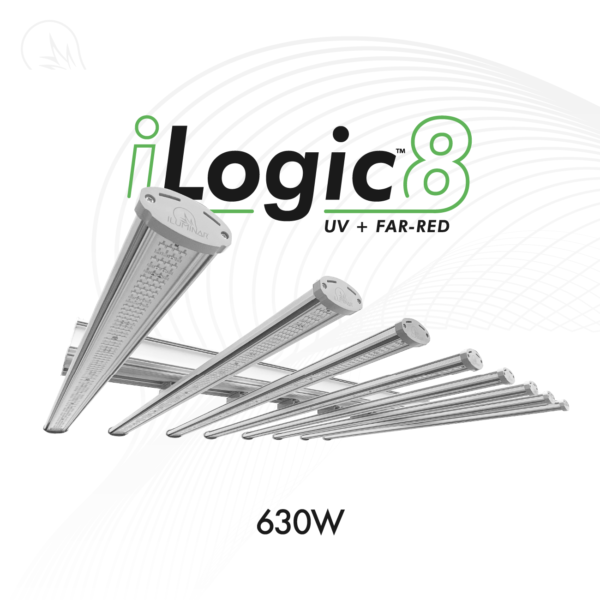
Features:
The 630W LED has a full spectrum array, specifically engineered for vegetative and flower cycles that require high μmol performance at a lower clearance to the canopy. Not only will this spectrum provide a more powerful and full spectrum for your plants, but the UV rays will also whip out any trace of powdery mildew that can be detrimental to healthy growth. Enhance trichome development increase yield with the state-of-the-art ILUMINAR iLogic8 UV+Far Red. Adding far-red to the light spectrum can increase leaf size, enabling plants to capture more light and potentially increase growth. Therefore, over time, far-red radiation can indirectly increase growth. Enjoy all the benefits of full spectrum & UV+Far-Red lighting without sacrificing efficiency. The iLogic™8 LED family delivers deep, penetrating light intensity along with industry-leading uniformity over a square 4’ x 4’ footprint.
Input Power: Smart Sensing™ 100V to 277V
Minimum Mounting Height: 8”-12” to top of Canopy
Emitter Cooling: Passive / Extruded Case
Dimming: 0–10V Controllable
Light Distribution:120º
Waterproof Rating: IP66 for Damp/Wet Conditions
LED Lifespan (90% of Life): 50,000+ Hours
Height: 124.3mm / 4.9"
Width: 1002mm / 39.4"
Length: 1064mm / 41.9"
How many plants can I grow under an LED grow light?
500 watt 8 sm., 4 med., 2 lg.
1,000 watt 12 sm., 6 med., 3 lg.
1,500 watt 16 sm., 8 med., 4 lg.
Small = 1 sq. ft. Medium = 2 sq. ft. Large = 4 sq. ft.
These are estimates based on industry averages. We always recommend calculating the actual needs of your garden. Allowing for slightly more light than you need will ensure optimal growth.
This is the million dollar question, right? How many plants can you get out of a grow lamp; maybe it’s more a question of how many lights you’ll need to reach your goals. To answer this question properly, we need to look at three characteristics. These three things will essentially be unique to every garden, and will be the ultimate arbiter in deciding how many plants you can grow per light.
System Design — This includes the type of light, the design of your indoor garden, and how much room you allowed for when building your garden. Is it a hydroponic system? Soil? Wall mounted or in buckets? Do you have large garden beds occupying tables in your garage, or do you have a climate controlled greenhouse that you grow out of?
Species and Size of the Plants — Obviously this is going to be a major factor. Growing petunias is different from growing watermelon, and that is different from growing tomatoes. The point is, selling yourself short and getting one 600w light may limit your ability to grow more than a few healthy plants at a time. It may be better to get more light than you need at the moment, if expansion or trying new plants is a possibility in your future.
Environmental Considerations — I don’t know about you, but I like to be prepared. Whenever I set out to build or fabricate something, I build it in my mind first in order to help realize tricky spots in the project. You might consider doing the same, as it can be frustrating to go to measure out where to hang your light because your plants are growing so well, only to learn that you can’t raise the light any higher. Thinking about any of the potentially troublesome areas in your garden, even writing them all out, can save you tons of trouble down the road
What are the light requirements of plants?
We all know that plants need light, right? In kindergarten we all put our seed in a dixie cup and place it in the windowsill. Add the other magical ingredient — water — and up comes the sprout, always moving towards the light.
Plants seem to instinctively “know” that without sunlight their growth will be stunted.
You can’t just use any light you find, however.
We’ve already covered some of the differences in the lighting options available to indoor gardeners, but how do we know which is better? First we need to know what makes light helpful to a plant in the first place. There are three factors that have substantial impact on how the light a plant receives will affect its growth. These factors are:
Light Quantity — Historically, light quality has been expressed in units called lumens. While useful to scientific research on light affecting human sight, the term did not accurately account for measuring the photon particles of light coming into contact with a plant. Botanists and horticulturists now prefer to use Photosynthetic Photon Flux Density (PPFD); an explicit measurement used to calculate the number of photons hitting a given surface — per sq. meter, per second.
A second term of value to plant science is the Daily Light Integral, which is simply a measurement that includes the photon density (PPFD) and the number of hours that a plant spends exposed to that rate of photon contact. Generally speaking, more light is required for flowering than for vegetativce growth.
Light Quality — As I mentioned earlier, not just any ‘ol light will do. We need special kinds of lights to grow plants. Why? When we talk about quality of light, particularly as plants determine it, we are really referring to spectrum — or color. All plants have photoreceptors that are triggered by photons of their respective spectrum entering the plant’s system. When taking light quality under consideration in your own project, ensure that your lights are either full-spectrum or that you have separate lamps to account for the spectrum of light needed at the different stages of growth.
Photoperiod (Light Duration) — The photoperiod is simply the amount of time the plants spend in the light or the dark. It can get a bit more complicated than that, however, as these light/dark cycles can be controlled to manipulate growth of indoor gardens. A popular example is found in applying large doses of light for 18–20 hours/day throughout the vegetative stage, then cutting the light down to ~12 hours or so to trigger the flowering stage. This is known as photoperiodism and is used to optimize growth and yields.
Conclusion
Your plants are living beings just as you are. You wouldn’t mind someone taking you to an all-you-can-it buffet so why not do the same for your plants. Choose wisely, see what our requirements are. If it is a bigger operation or a business project, you will have to spend that extra buck. Anyway, we hope this was a helpful guide. We wish you all the luck in finding the best LED grow light for cannabis.
Mammoth Lighting Commercial Series 8 Bar 640 Watt LED Grow Light VS GROPLANNER LED GROW LIGHT 640W- GROPLANNER I SERIES
July 07, 2021
Choosing the type of grow lights you use for your ACMPR grow op is a major decision. We can’t tell you which one to use, but we can tell you that LEDs have been steadily gaining popularity over the past decade or so (even though they’ve been around since the 60s).
So why have they become so popular? First off, LED grow lights are a lot more affordable than they were in the past. But more importantly, these are the most energy-efficient bulbs on the market. And on top of that, LEDs give off the full-color spectrum of light, which your plants will thank you for.
Comparing LEDs to Other Bulb Types
Even if you’ve got high energy efficiency on your grow room agenda, LEDs aren’t the optimal choice for everyone. Sure, LED grow lights yield well and they conserve power, but before deciding that LEDs are for you, it’s important to also consider other bulb types.
When you compare HPS vs LED grow lights, HPS bulbs tend to produce more intense light per watt (this is why it’s considered a high-intensity bulb). The downside is that they also use a lot of energy and produce a high heat output.
But, when used properly, HPS (short for high-pressure sodium) bulbs often produce a higher yield than high-intensity led grow lights. You just need to be aware that there’s a greater risk of overheating with HPS (and CMH) bulbs.
The other common comparison is between CFL vs LED grow lights. CFL (short for compact fluorescent lamps) is a great choice for the early stages of the grow op, but they can’t handle flowering the same way that LEDs can.
How close should LED grow lights be to plants?
The placement of your grow lights depends entirely on the type of bulb, so even if you know all about HPS or MH placement, the rules for LEDs are completely different. So when learning how to use LED grow lights, pay close attention to the number of inches from the plant canopy.
When comparing HID vs LED grow lights, LEDs have a much lower heat output than high-intensity bulbs. This means that they can be placed closer to the plant canopy without risking plant scorch or overheating.
And remember, the higher the wattage, the higher you should hang your lights. When using the best LED grow lights for indoor plants, follow these basic tips for placement:
240–400W LEDs: 16–24”
450–550W LEDs: 20–30”
600–850W LEDs: 24–26”
900W+ LEDs: 26–42”
Mammoth Lighting Commercial Series 8 Bar 640 Watt LED Grow Light
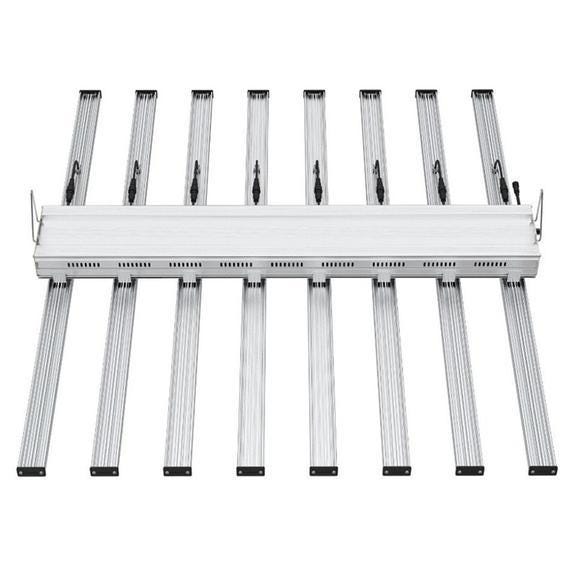
Features:
Mammoth Lighting’s Commercial Series 8 Bar 640 Watt LED Grow Light was developed by expert indoor growers over years of careful experimentation and testing. Mammoth LED grow lights are manufactured using the highest quality Samsung diodes. These powerful lights deliver a continuous range of wavelengths from blue and green to red, creating a light blend matching the natural sunlight.
This is accomplished by using more light bars, more diodes, and an overall larger physical footprint — spanning 47" x 42" — compared to any other LED manufacturer. With 1720 umol/s of PPF and a PAR rating of 2.7 umol/J, the Mammoth Lighting 8 Bar fixture is an efficient, intense, grow light powerhouse. Mammoth customizes their light spectrum to optimize plant growth and increase yields while consuming less energy and reducing operating costs compared with traditional grow light technologies.
PPF: 1720 µmol/s
Power: 8 bar 640W,
Voltage: AC100–277V 50–60Hz
LEDs: SAMSUNG LM301B
Spectrum: 3500K + 660nm
LED lifespan: 50000 Hours
Dimension: 47" x 42" x 4"
Veg Footprint: 6' x 6'
Flower Footprint: 4.5' x 4.5'
Power: 640 watts
Light Output: 1720 µmol/s
HID/HPS Equivalent: 1000 watt
Dimensions: 47" x 42" x 4"
Manufacturer’s Warranty: 5 years
GROPLANNER LED GROW LIGHT 640W- GROPLANNER I SERIES
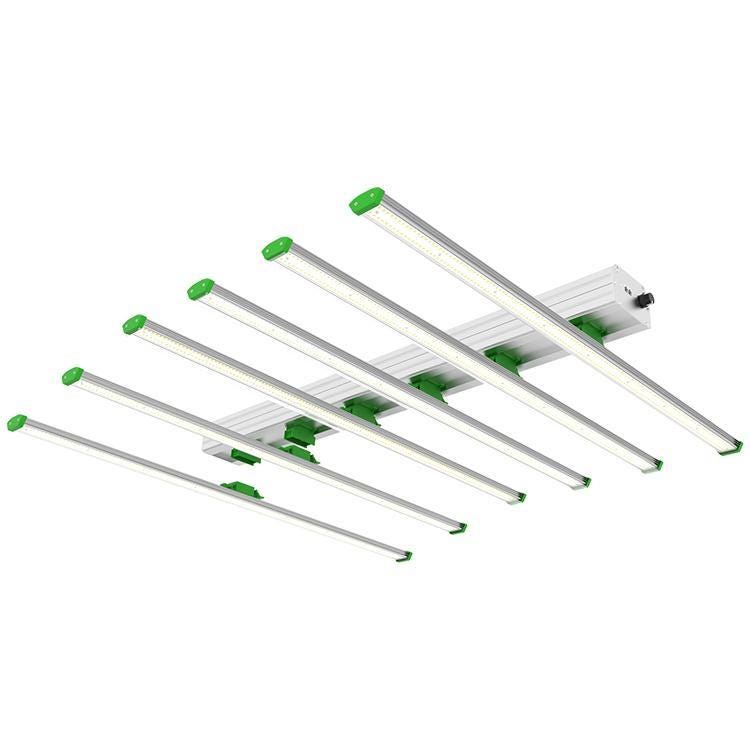
Features:
This GROPLANNER LED grow light has a balanced lighting design, which is enough to cope with complex indoor use environments. The actual power is 640W, and it provides PPF output (1750μmol/s), allowing you to obtain a higher output of 30% to help you achieve maximum quality and Quantity, better than the traditional growth system. It is very suitable for 5'x5' plant coverage and 6'x6' reduced coverage, which greatly improves the light coverage. The advanced design effectively expands the light area. At the same time, the lighting is more uniform. With a high energy efficiency of 2.75 umoll/J, it also provides a high-quality and complete natural spectrum from 400nm to 700nm. There is no need to worry about heat dissipation even with high power. The aluminum cooling plate using advanced small molecule materials, plus the heat sink of each chip, achieves an excellent heat dissipation effect. All these designs make the heat dissipation efficiency high. No fan, no noise.
Power consumption:640W
Light Color:Full Spectrum
PPF: 1750μmol/s
Efficacy:2.75 μmol/J
Dimming:0–10V
Heat:120°F
Lifetime : >60,000 hrs
Input Voltage:120–277VAC,50/60Hz
Thermal Management:Passive-Cooled Design
Coverage:5'*5' for Flw, 6'*6' for Veg
WHY CHOOSE A FULL SPECTRUM LED GROW LIGHT?
If you have done some research online, you may be wondering why everyone seems to be touting full-spectrum LED grow lights. There’s some science behind this, but we’re here to break it down so that it’s easier for you to understand some of the reasons why full-spectrum LED grow lights are considered the best LED grow lights.
Ever wondered why many farmers still prefer to plant outdoors where possible? This despite land scarcity, exposure to the elements, etc.? Well, it turns out that sunlight plays a huge part in this. Sunlight offers the whole spectrum of visible light which is important because many plants require different colors of the light spectrum during different growth stages.
If you only use a certain type of LED grow the plant, it’s likely that your plants will not have the appropriate color spectrum for one of the growth stages. Blue LED lights, for instance, maybe great when it comes to encouraging vegetative growth, think plants that grow tall and leafy, but they aren’t so useful if you are at a stage where you want your plant to bud and flower.
In fact, this is where blue LED lights alone may result in not-so-ideal situations where your plants turn out to be busy with minimal buds that can eventually flower. Red LED lights, on the other hand, are really beneficial for the budding and flowering of plants, but this alone is also not sufficient if you want your plants to eventually grow tall and healthy.
That said, you may think that it will be fine for you to just get red and blue LED lights. Well, that’s not the end of the story. While there are different views on the value of ultraviolet light, there has been some research that suggests that the use of ultraviolet light in short bursts can help to boost THC production, i.e. increase the potency of the growing cannabis.
As for white LED light, it isn’t particularly helpful to the growth of the plants, but in an indirect way, it helps you, the grower, better see and resolve any potential problems in your grow room. These aside, research also suggests that plants are used to growing with the full spectrum range that’s available from sunlight, which is probably why the isolated use of blue and red LED grow lights may still not be an ideal way about it.
Since full-spectrum LED grow lights mimic real sunlight, it is probably best to use them in your grow room to achieve the best possible outcome. This is also why all of our recommended LED grow lights below are full-spectrum LED grow lights or at least LED grow lights that come with some combinations of the different spectrums that are essential for particular crops they are designed for.
Conclusion
LED grow lights are capable of producing beefy plants and high yields, all while maximizing energy efficiency. After figuring out your ideal wattage based on grow room coverage area, start using one of these LED light systems and let us know how it goes!
AGLEX M240 LED Grow Light Bar for Indoor Plants VS Advance Spectrum 240W Sun Series Model E 4-Bar Full Spectrum LED Grow Light
July 06, 2021 1 Comment
LED grow lights are an excellent investment that will benefit the growth of your plants and crops. But, you’re shopping in 2021, when the market is overwhelmed with so many products. The chances are you need help in making the right decision.
How LED Grow Lights Work
LED bulbs produce light due to electricity flowing through them, but some energy is not being permitted to leave. Diodes allow current to only flow in one direction, and so the resistance is shed as light. The chemical makeup of the LED’s material determines the type of light they shed.
Some light is easy to produce with a little chemistry, others took a lot of work. A full spectrum LED is actually a tricky thing. Some produce it with clusters of single-color LEDs to emit some or all of the spectra you want. Others have a complex chemistry feat, managing to emit all of them from a single component. This is done based on voltages fed into them.
Some of these broad-spectrum LED panels only emit white and UV light. LEDs can produce white light as actual white light, rather than combining component sources to produce it. Others are more advanced, capable of individual colors as well.
LED Grow Lights Benefits
Adjustable Light Spectrum
Unlike other light sources, you can adjust the spectrum for the different plant stages (clone, vegetative & flowering). For cloning and vegetative plant growth stages they require light in the blue range (400–500nm) spectrum. Once you switch your marijuana plants into the flowering stage it is highly recommended that you include a 600–700nm red spectrum.
Since we all want huge marijuana buds, the red spectrum is the most important spectrum. In a traditional indoor garden, you would use a metal hydride for growing and then switch out to a High-Pressure Sodium (HPS) bulb. Using a switchable led grow light can be done with the flip of a switch, making it extremely easy to switch growth stages.
Energy Efficient
The average led grow light uses approximately 40% less energy to produce the same output compared to HPS bulbs. In a small closet or grow tent indoor garden using a conventional HPS bulb you would need to have an inline ventilation fan to control the temperature. panels run so much cooler so no additional fans are required. Total energy saving can be as much as 60%.
Lifespan
The average lifespan is 50,000–100,000 hours for grow lights. HPS bulbs are rated up to 20,000 hours but their output drops dramatically after 5,000 hours. It is recommended that you switch out your HPS bulbs every 12–18 months to get the maximum output. LED grow panels on the other hand continue to provide the same output during their entire lifespan.
Size
LED grow lights are much thinner and have the reflector built-in. A standard HPS uses 1–2 feet for the bulb and reflector and an additional 1–2 feet between the bulb and plant tops. The average 300 watts LED panel is only 4 inches thick and can be placed within inches of the plant tops. For a very small closet or grow tents indoor marijuana gardens where space is at a premium, LED panels are your best choice.
Here are two great LED grow lights for you, including theirs. Hope it can help you.
AGLEX M240 LED Grow Light Bar for Indoor Plants

Features:
AGLEX led grow light comes with upgraded SMD 3030 chips and 4 efficient aluminum bars, ensuring higher efficacy PPE 2.8umol/J and better heat dissipation, longer lifespan. Max 2.8g yield per wattage with 30% higher average PPFD and 50% greater yield & quality compared with the old plant lights. Only consumes 240w with 448 LEDs, perfect coverage for 4x4.5ft, The 240w led grow light M240 will help you achieve maximum quality and quantity. The 240w led grow light is equipped with an external driver and dimmer, power cord length 76.5 inches. This plant grow light is with special dimmer, can be adjusted at accurate brightness. 0–10 levels available. That means you could see clearly brightness level and record it when you adjust it. Consists of full-spectrum White 3000K 5000K, Red 660nm, and IR 740nm, infinitely close to natural sunlight. Excellent spectrum applies to the whole stages of indoor growing plants. The full spectrum led grow light is with 4 efficient aluminum bars. No fans zero noise design, very quiet. The led grow light 240w is ideal for greenhouses, grow tents, stand racks, vertical farming, etc.
Model Number: AGL-240W-M01
Actual Power: 240W±5%
LED Quantity: 448 LEDs
Perfect Coverage: 4x4.5ft@12”
LED Lumen: 56822 LM
PPFD: 1226muol/㎡/s
PPE: 2.8 umol/J
Input Voltage: AC100–277V
Frequency: 50–60Hz
Dimensions: 23.64” x 21.28” x 1.69”/ 600 x 540 x 43 mm
Item Weight: 9.02lbs (4.1KG)
Lifespan: >50000 Hours
Materials: Aluminum
Working Environment: -20~40℃,45%RH~90%RH
Advance Spectrum 240W Sun Series Model E 4-Bar Full Spectrum LED Grow Light
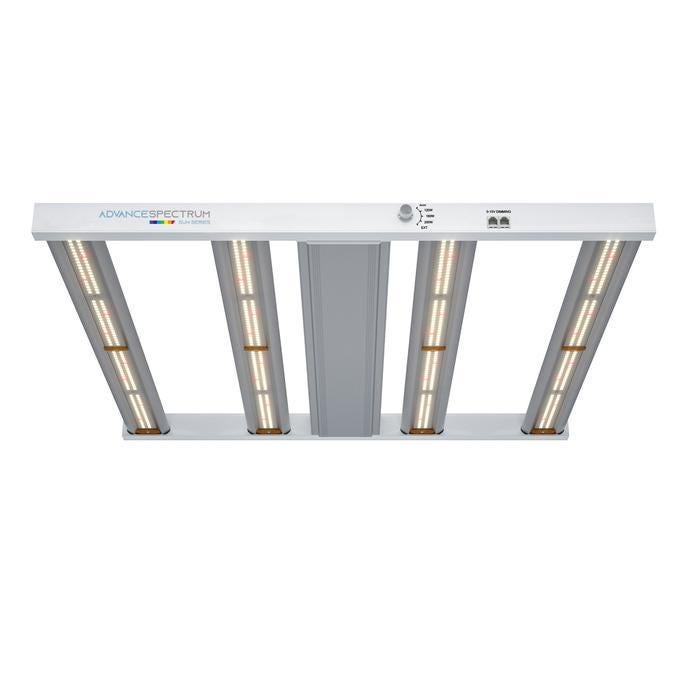
Features:
Advanced Spectrum 240W Sun Series Model E 4-Bar Full Spectrum LED Grow Light comes with a full spectrum design closer to the natural light. Plant exposure to the grow light bar boosts the terpene level. It ensures better and complete plant growth — from seedling to harvest. This high-performance LED grow light works well with plants grown in water and soil. The plug-and-play system is easy to implement with minimal cost. All die-casting aluminum bodies offer great heat dissipation for the long life span of the light. It ensures that the system stays cool and consumers get high output. The grow light comes with a manual dimmer that helps you manually set the right spectrum for the plants at different growing stages. It offers you complete control over the output. This highly efficient LED grow light offers more than 50% energy savings. By replacing your fluorescent tubes and other conventional lights, you can save a significant amount of money. It is also foldable and light. This makes this full-spectrum LED light easy to set up and move from one place to another. The model performs silently. So, it ensures no disturbance to you and others at all when it’s running.
SKU/Model No.: LED-AS-240W
Full Spectrum LED Model E 240W
Full spectrum led grow light and designed for commercial horticulture
Driver Box in Middle
China Driver,Input Voltage: 110–277V
0–10V Dim & Manual Dimmer
Size: 24 24INCH/ 60 60CM
2*2 FT/ 4 Light Bars/ L7009–240W
184pcs LEDs per bar/ 736pcs in total
Mid Version (China 3V 3030)
LED Efficacy: 2.7μmol/J, Total PPF: 648μmol/s
What to look for when buying a LED grow light for indoor gardening
Lightweight
Everyone prefers a product that is lightweight and easy to carry. If you ever want to move the led grow light panels from one place to another, you’ll appreciate ones that are lightweight. Also, they are much easier to install. The most recent LED grow lights panels are designed to look pleasant to the eye and not take too much space. That’s what also makes them light. When you see the panels, you’ll notice that they are thin, which is very handy when you have many of these over a larger area.
Since there is a good and a bad side to everything, we wanted to mention the cons of a lightweight product. If you have a LED light that doesn’t weigh too much and hangs above plants, it’s effortless to move if you touch it or if something touches the cords. That’s why sometimes these lights are hard to stay put, which takes away from the quality of the light over your plants.
Brightness
Light intensity is one of the essential features of LED grow lights. It’s measured with PPFD, which is short for Photosynthetic Photon Flux Density. This measurement describes how many protons fall on one square meter per second. It’s actually the light that plants will absorb. If there is a high PPFD, the light is considered more effective.
People see this phenomenon through their eyes and describe it as brightness. Brightness is the sensation, while PPFD or light intensity is a measurement.
Not all plants are the same, and that’s a fact. That’s why you should educate yourself about the intensity of brightness your plants require during different stages of their growth. For example, many flowering plants require between 300 and 600 umols during their vegetative growth, while they require between 800 and 1,000 umols during their flowering stage. You don’t want the LED grow lights to be too close to the plants or too far away from them. It’s best if you follow the instructions of each manufacturer.
Energy Efficiency
LED lights are efficient in so many ways compared to other traditional types of lights. They use the same amount of electricity but use it sparingly and smartly. They preserve this energy, and while they’re plugged in, there is no energy waste.
These days, there is a high competition rate between manufacturers, so each one tries to create a more energy-efficient product. Although having grow lights turned on for long periods of time sounds scary and expensive, that’s not quite the case. LED lights are a thing of the future, and they get better each year. They use electricity, but they store it and use it more efficiently than other types of lights.
These latest LED grow lights feature an auto-shutoff feature that will help you schedule when they go off and save electricity. If you had to do that yourself, the chances are sometimes you’ll forget and end up getting a much higher bill.
Another pro of these lights is that they generate less heat, saving you money on the cooling costs in the room.
Temperature
LED lights can overheat, so that’s why it’s essential that they don’t generate too much heat and that they have a specific cooling system. Most of the LED grow light panels that you’ll see don’t have a fan, but they don’t overheat either. That’s thanks to their advanced designs. However, there are also ones that heat a lot and can negatively impact your plants’ growth.
One of the reasons brands don’t install fans is because they’ve found a way to create a design that gets rid of heat through heat sinks and doesn’t generate noise. These sinks are usually located in the back of the unit and get rid of the heat before it gets to the plants. Fans can be noisy but also do a fantastic job of keeping the device from overheating.
Value for Money
Value for money is a feature you have to consider for every product you’ll buy, not only for LED grow lights. When reading reviews, make sure that the lights that you’re buying are exactly what you’re looking for. That’s how they’ll fulfill their purpose and will be worth every dollar that you’ll pay.
Also, try finding a product that is durable and lasts for a long time. Scroll through reviews to see how other customers describe the durability of the LED light you’re interested in. It’s beneficial to offer a warranty that will cover refunds if something happens to the LED grow light. That’s the safest way to know that you’ll be getting what you paid for.
LED grow lights have a high initial cost, but they will justify the cost by lowering your electricity bills. That’s another reason why these lights bring value to your home and indoor garden. They have a long life span, which leads to the fact that they are environmentally friendly and durable.
Conclusion
Trying to find the best LED grow lights may seem like a challenging task. But once you figure out what factors really deserve your attention, you will easily narrow down the options and pick what would work for you. Just make sure you get the suitable wattage and light intensity for your plants and tent size. Plus, don’t forget to always check the warranty and what it covers.
How to Trim Your Indoor Plants-The Complete Guide
July 05, 2021
As a cannabis cultivator, interacting with the cannabis plant often as it grows teaches you much about producing happy, healthy weed that has all the nutrients it requires and regular clean pH-balanced water.
After months of attention and effort in your cannabis garden, trimming is very essential to have a successful cannabis harvest, and it is important to do it in the right manner and use the correct tools. Not only will it make your plant look better, but it will also help increase its potency and reduce the smoke's harshness, too.
The natural structure of the cannabis plant looks like that of a Christmas tree and for many cannabis growers, the height of the plant needs to be controlled. Trimming harvested cannabis can be an exhausting task for those who have never done it before. However, believe me when I tell you that with a little know-how, you’ll see that it can be pretty easy!
Why is trimming marijuana important?
Trimming involves, first, bucking buds off branches. Then sugar and fan leaves need to be removed — leaving them on would cause a harsh smoke, as the foliage is thicker and doesn’t wick away moisture as well. Sugar leaves have some trichomes but much less than buds. Removing them will expose parts of the nug with more trichomes.
Cannabis that has been trimmed also takes on a tighter, more uniform appearance and is more aesthetically pleasing. It will look like the weed from the dispensary.
Trimming is also important for curing — during the curing process, trimmed buds have a more uniform moisture content, creating a much more even and flavorful smoking experience.
What You’ll Need Before Trimming
Sharp scissors (for trimming buds)
Trimming Shear is our weapon of choice. The blades are thin and sharp, which makes it easier to get your bud looking perfectly manicured. They also have a built-in spring to automatically open the blades after each snip. That ends up saving a lot of work for your hands by the time you’re done trimming.
Any “bonsai scissors” usually work well for trimming. These bonsai pruning shears are popular because they’re cheap, sharp, and spring-loaded.
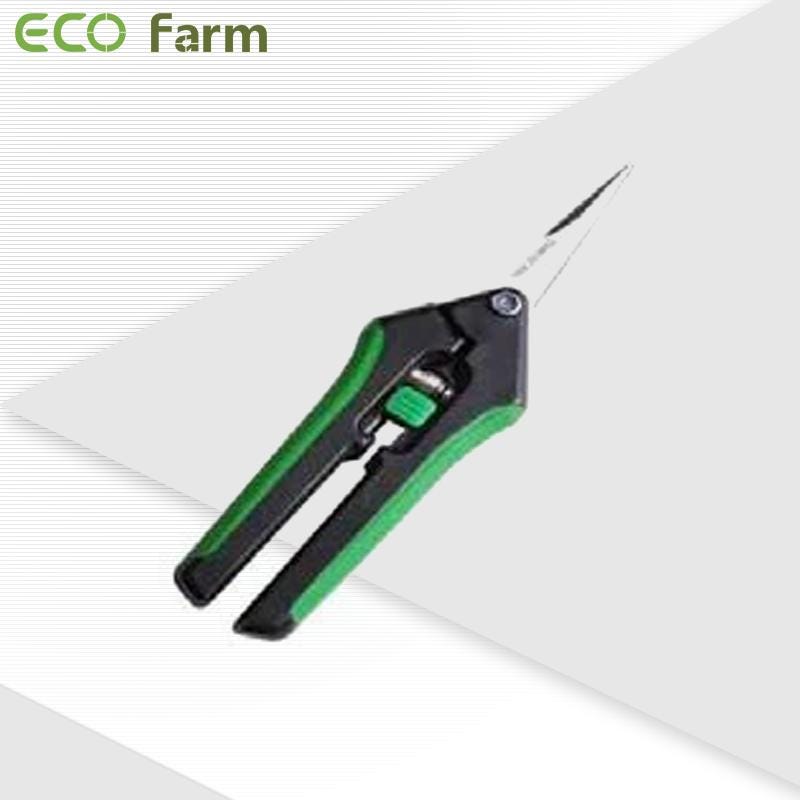
Pruning shears, or tough scissors you don’t mind destroying (for cutting off branches) These will be used to actually cut down single branches as you harvest colas to be trimmed.
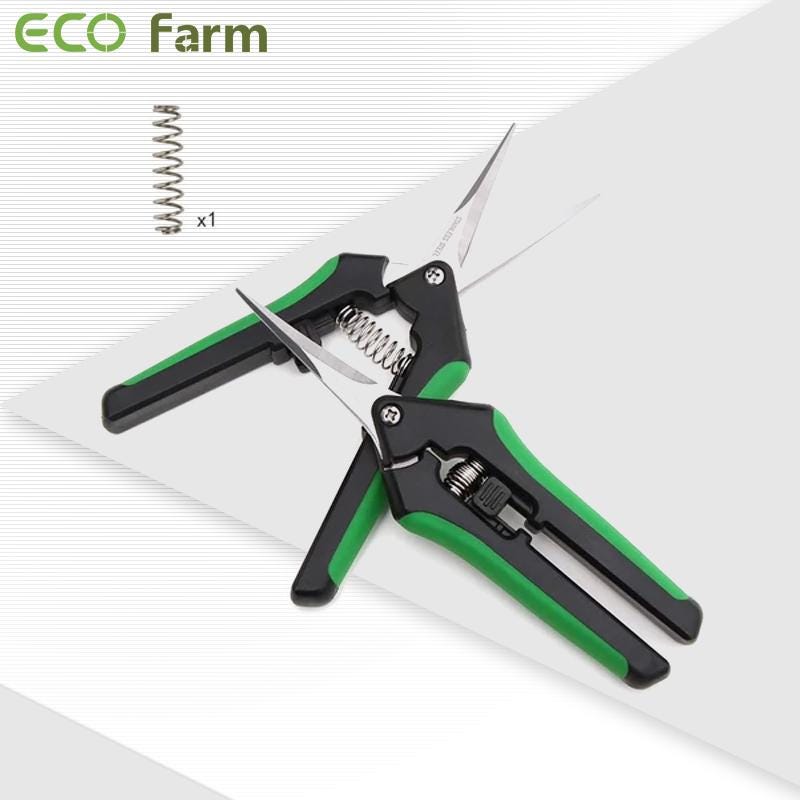
If possible, try to use a separate pair, and not the same sharp scissors you plan to use for trimming buds. Some branches are tough enough to destroy a pair of nice scissors in a single harvest. You want sharp scissors for trimming your buds; it will save you so much time!
Disposable gloves
Disposable gloves help protect your hands from your bud. Handling bud without gloves will make your hands sticky to the point where it becomes a constant problem. Plus, hands covered in resin are difficult to clean.
Disposable gloves keep the resin off your hands, and hand particulates off your weed!
Trays or Cookie Sheets
You need a tray to hold your untrimmed buds, one to hold your newly trimmed buds, and the last one to hold your ‘trim’ (the plant matter you cut off the buds)
Use cookie sheets or any clean sizable containers to keep your trimmed weed, untrimmed weed, and trim separate.
Of course, you can use anything to keep your separate piles in, but cookie sheets have worked really well for me! Baking sheets work nicely and are cheap, but honestly, any non-absorbent flat surface will work. I like cookie sheets and other wide cooking pans because they have a lip around the edges to help keep everything contained!
Once you have all of your gear assembled, move onto the steps below when you feel ready. Keep in mind that this can be a lengthy process depending on how much bud you’ve grown. However, any negative feelings you get from the labor of trimming will be far outweighed by all the bud you’ll be drying soon!
One last thing… Don’t forget to save all your leaves and other trim! You can use the extra leaves you cut off to make edibles or hash. If you can see trichomes (“glitter”) on the leaves, that means they have good stuff to extract! If a bud is very small or wispy, sometimes I’ll throw that in the trim pile as well.
Trimming your plants: a step-by-step guide!
Set up an area where you want to trim. This will be the space that houses all your trimming supplies while you trim. It’s also imperative that you get comfortable with the area because trimming takes a whole lot of time and it won’t be enjoyable if you choose a spot that creeps you out.
Wash your hands and put on a pair of gloves.
Use your gardening shears to cut a branch off your cannabis plant.
Remove the large fan leaves with your fingers. They are leaves that can be removed without any difficulty from their stem. They are to be put in a pile to be disposed of later.
There are some small leaves that stick out of the buds; allowing you to see the leaf tips but not the stems. These are usually referred to as “sugar leaves” and don’t need to be removed, only trimmed with your scissors if they stick out. Sugar leaves are cut so they are flush with the bud, giving it around, almost smooth appearance
All that you should be left with is a trimmed plant. Now that you’ve got the hang of it, repeat this process on the remainder of the branches on your cannabis plant! After trimming, your scissors (and fingers) will be covered in hash which is concentrated cannabis resin that you can vape, smoke, or consume. Not a bad reward for a day’s work!
Ensure that you keep all the ‘trim’ (the leaves trimmed from your bud) in its designated tray. This not only helps save more trim for the hash, but it will also help you with clean-up later! Try as much as possible not to cut off any of the actual buds, but if this happens by accident, you can throw it in the trim pile.
In addition to manual pruning, some people choose to use a machine to trim, because it is very convenient and labor-saving. This depends on personal choice.
If it’s hand trimming, I recommend you ECO Farm 16/19 Inch Manual Leaf Bowl Trimmer Machine.
If it is machine pruning, I recommend you ECO Farm 18inch Table Automatic Leaf Trimmer Machine.
Hand-trimmed vs. machine-trimmed weed
As a home grower, you’ll most likely be trimming your weed by hand, but some do invest in machine trimmers to cut out the monotonous trimming part.
Pros and cons of hand trimming indoor plants
Pros:
Cheap
You can shape each individual bud and bring out the qualities of each strain
You can spot issues like mold or insects
Cons:
Messy (you’ll want lots of rubbing alcohol or coconut oil around)
Time-consuming
Usually have to rely on some buddies to help
Pros and cons of machine trimming indoor plants
The high demand for cannabis has paved the way for new technologies and a whole range of machine trimmers. These trimmers do an incredible job of processing buds quickly, so they’re mainly used by large-scale growers producing for the low end of the market.
Pros:
Easy
Quick and efficient, saving time and money
Less messy; machine trimmers collect trim easily so you use it for other products
Cons:
Can overtrim buds
They knock off a lot of trichomes, affecting potency and flavor
Stems and seeds can still make their way into finished buds
Conclusion
As with all cannabis cultivation, trimming post-harvest requires a bit of thinking and some planning to minimize the risk of being discovered. While it is inevitably a tense few days, the best way to get through it is to make sure you have sufficiently prepared! Good luck and happy harvesting!
ECO Farm 480W V3Pro Samsung LM301H Movable LED Grow Light VS Geeklight grow light 480W with top bin lm301h/b hydroponic led grow light
July 03, 2021
LED grow lights are relatively a new addition to the cannabis cultivation landscape. Over the past few years, LED grow lights are leaving their mark with their unprecedented ability to produce great yields without producing heat while using minimum electricity.
Recent years have witnessed rapid improvements in LED lights technology. With the introduction of customized lights specifically designed to meet cannabis cultivation and growth needs, marijuana LED grow lights have become an indispensable part of cannabis indoor cultivation. These custom-made lights owing to cannabis centric specifications help to produce better yields, density, and plant growth rates than older generic models.
Why Choose LED lights?
There is a multitude of factors that underscore the importance of LED lights for indoor cannabis cultivation and growth. The following can be among the reasons you can base your LED lights purchase decision on.
LED lights present cutting-edge indoor cannabis grow light technology; you can meet light requirements of your indoor plants by making use of the customized spectrum of LED grow lights.
In case, issues of space and ventilation are important to you, particularly, when you have a small grow space, LED grow lights offer the ultimate solution to your growth needs.
Coming in a compact structure, LED grow lights are easy to install and handle. All they require is just hang them at an appropriate distance above the cannabis plants.
They offer flexibility; by placing them side by side better light coverage can be achieved.
Since marijuana grow lights don’t emit heat, therefore, there is no need to install and operate a heat ventilation system.
Their modern technology makes them energy efficient, consequently, they only consume half of the electricity as compared to the traditional lights.
Their small size and compact structure make them an indispensable part of the modern marijuana indoor spaces.
ECO Farm 480W V3Pro Samsung LM301H Movable LED Grow Light
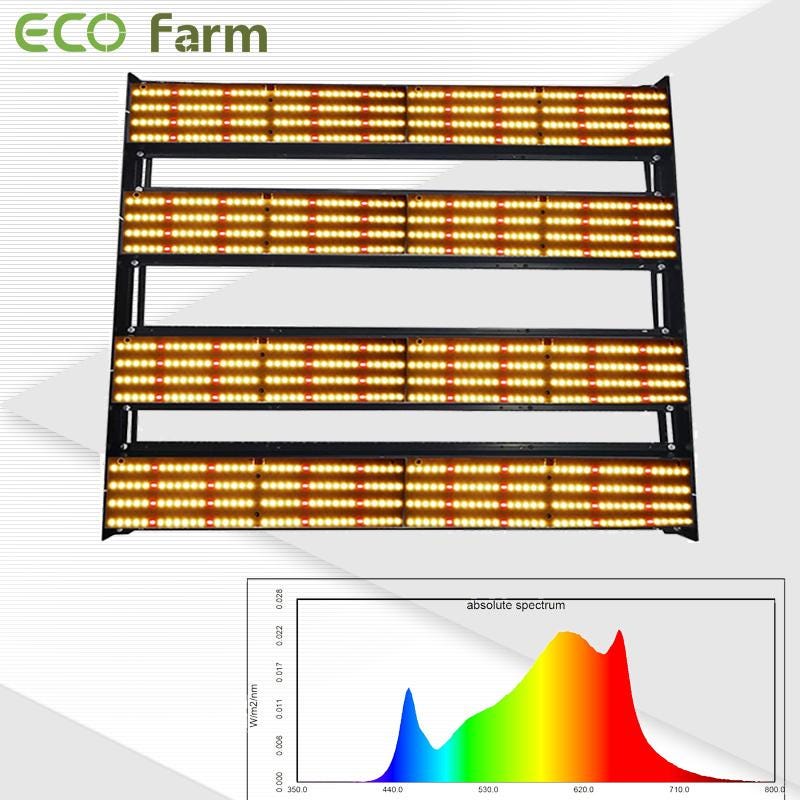
Features:
This ECO Farm LED grow light is an optimized full-spectrum grow light suitable for indoor plants. Our spectrum is 3500K warm white and 660nm deep red to optimize plant growth in indoor/greenhouse environments from seed to harvest. (Sprouting, cloning or shearing, mother, plant and flowering applications). 3500K-Promote plant biomass growth, red 660nm-Promote stem growth and flowering, increase yield; suitable for all stages of indoor growth. Up to 1262μmol/s light output PPF, 2.6umol/J of high energy efficiency. Recommended vegetable size is 5x5 feet and flowering size is 4x4 feet. No fan and no noise. High safety performance HLG MEAN WELL driver. The actual power is 480w. Utilize the special surface treatment of the aluminum radiator to increase the heat dissipation area.
Item:480W V3Pro
Spectrum:LM301H 3500K + Epistar 660nm
Led Diodes:1024PCS LM301H +192PCS 660nm Epistar
Total Led Quantity:1216PCS
Power:480W MeanWell Driver HLG-480H
Voltage Range:100–277V
Photon Efficacy:2.6µmol/Joule
Lamp Luminous Flus (Lm):76800Lm
Efficiency:160Lm/w
Total output — PPF:1262μmol/s
PPFD at 40CM:1923μmol/m2/s
Flowering Footprint (coverage):4*4ft
Veg Footprint (coverage):5*5ft
Collor temperature (K):3500K
Frequency:50/60Hz
Color Rendering Index (CRI): >80Ra
Electric current intensity:2100mA
Dimensions:58.5 x 58.5 x 3cm
Geeklight grow light 480W with top bin lm301h/b hydroponic led grow light
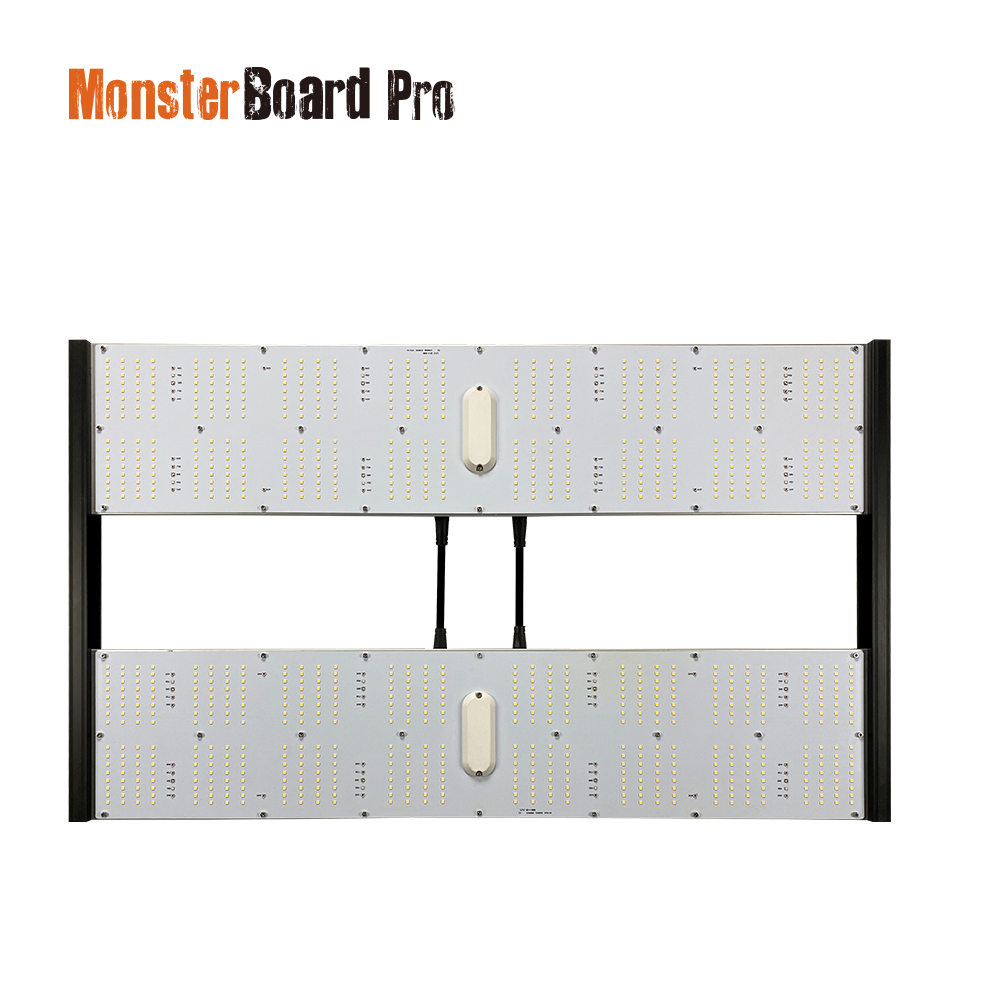
Features:
Geeklight grow light has top bin lm301h/b and UV IR smart app control. High energy efficiency of 2.75 umol/J; extremely high output, more efficient than traditional HID lamps and other plant lamps on the market. RJ12 daisy chain hydroponic led grow light. Monster board pro support to exchange from Veg to Bloom pattern, gaining higher yield in different stage; Daisy Chain function can bring you big convenience to control all lights through one light or control box; Uniform par map can Help plants grow more uniform. It has a unique appearance, through power supply and ventilation holes, no fans, low noise, and very low ambient heat, so there is no need to worry about burns or damage to plants.
Led chips : lm301h/b+osr 450nm & 660nm+UV+IR
Emitting color : 3000K+450NM+660NM+UV+IR / 3500K+450NM+660NM+UV+IR
Light size : 89x51.6x7.3cm
Working hours : >50000
Certification : CE, RoHS
Warranty : 3-years
Veg footprint : 5‘*5’
Flower footprint: 4‘*4’
CRI(Ra>) : 80
Lamp Luminous Flux:n*83
Determining How Much Light Coverage You Need
When searching for LED grow lights for your hobby hydroponic garden, you’ll notice they are grouped by wattage. LED grow lights typically range between 300 to 2000 watts.
Below is my recommended coverage of an LED grow lights by wattage. I would recommend that you give your plants 50 watts per square foot during the vegetative stage. Wattage per square foot increases during the blooming stage, I would recommend providing as much as 80 watts per square foot. Keep in mind the shape of the grow light can affect the coverage area and coverage dimensions.
LED Wattage/ Vegetative Coverage/ Bloom Coverage
300 Watts ~2.5ftx2.5ft ~2ftx2ft
600 Watts ~3.5ftx3.5ft ~2.5ftx2.5ft
1000 Watts ~4.5ftx4.5ft ~3.5ftx3.5ft
1200 Watts ~5ftx5ft ~4ftx4ft
1500 Watts ~5.5ftx5.5ft ~4.5ftx4.5ft
2000 Watts ~6ftx6ft ~5ftx5ft
LED Grow Light Lifespan
LED grow lights last a lot longer than other types of grow lighting. With that being said lifespan is not the same for all lights.
LED grow lights typically have a lifespan between 50,000 to 100,000 hours. While even on the low end 50,000 hours of use equates to about 8.5 years, but when the lifespan doubles to 100,000 hours that life span is now at a little over 17 years.
When researching different grow light option make sure to factor in how long the light is going to last.
How to Pick the Best LED Grow Lights
Choosing the Right LED Grow Lights
If you do not choose the correct LED grow lights for your agricultural operation, your crops may suffer. When you use lighting that fulfills your plants needs you can have a much greater yield. At RF Agriculture, we have many varieties of LED lights. Below we’ve rounded up our best tips for selecting growth promoting lights.
What should I consider before purchasing my LED grow lights?
The most important factor to consider is which grow lights work best for the specific plants you will be growing in your operation. Houseplants, flowers, cannabis, fruits and veggies — all have different, specific lighting requirements for optimal growth, and some types of LED lights produce light spectrums specifically tuned for certain plants.
The second aspect that you will need to consider is the exact size of your growing space. This will help you to determine the size and number of lights that you need.
Here are some more important factors to consider when deciding what type of LED grow lights you will need: if you are growing your plants from a seedling to a flower bloom, you may want to consider a full-cycle light. Some of the most popular LED grow lights today are programmable. With these you can set a schedule, as well as control the lighting spectrum and intensity to meet your plants’ individual needs.
What are the primary benefits of LED wholesale grow lights and how do they compare with others on the market?
LED lights are a great choice for stimulating indoor plant growth because they are extremely energy efficient, environmentally friendly, and durable. If you are looking to use less energy at an even lower cost LED lights are a great choice for your growing operation.
HPS grow lights vs LED
HPS (high pressure sodium) lights are preferred by some indoor growers because they emit a wide color temperature spectrum. HPS lights can grow most any flowering plant well and are especially effective during the flowering stage of your plants’ growth cycle. However, HPS lights produce a lot of heat and are less energy efficient than LED lighting options.
Should you consider MH grow lights over LED?
MH (metal halide) lights are one of the best options available for growing healthy greens, but if you are growing flowering plants, it’s important to note that MH lights often fall short in production of red-spectrum light, which is crucial for flowering plants. So if copious and healthy blooms are what you need from your plants, LED lighting might be the best way to go for your growing operation.
Conclusion
LED grow lights are the latest illumination devices that can effectively provide light to indoor cannabis plants. A range of benefits associated with this lighting system makes it an integral part of the indoor cannabis spaces.
There are different types of greenhouse LED grow lights. Before you illuminate your indoor garden consideration of these types along with knowledge of their related pros and cons can help you choose the best LED lights.
ECO Farm ECOM 320W LM301B Full spectrum LED Grow Light Bars VS DLI Diode LED Toplighting Indoor Fixture for Indoor Plants
July 02, 2021
Some houseplant owners are lucky enough to have a home with endless amounts of sunshine, but for some of us, grow lights are critical for houseplant survival! I used to be really intimidated by the concept of grow lights. It just seemed complicated, artificial light, you know? Guess what — it’s not as hard as you think!
Plants get the energy they need to grow from sunlight through photosynthesis. If you don’t have enough sunlight for your plants, your plant will not grow properly and might even die. This is why grow lights can be SO important for houseplants that don’t receive enough natural sunlight.
What size LED grow light do I need?
Most first-time indoor growers don’t know too many things about the process and often ask themselves what type of LED lights to pick. When it comes to the perfect size, there is no single answer, as the size depends on the total area you wish to grow plants on, and other factors.
Before buying any set of LED lights, consider the type of plants you want to grow. Each plant requires a certain amount of light to bloom and thrive, and even the slightest changes can burn the plant or interfere with its natural growth process.
The growth space area is another important factor to take into account when picking the size of your LED lights. As a general rule, you will need a minimum of 33 watts of LED supply to provide enough light for one square foot of growing area. That being said, if you want to grow an area of about 16 feet, the capacity of the LED lights should be around 500–550 watts.
Which color of light is best for growing plants?
Full-spectrum light contains all colors of the light spectrum. Since natural light from the sun is full spectrum, full-spectrum light is best for growing plants. Some artificial lights emit one color such as red or blue, so for houseplants, make sure you are purchasing a full-spectrum light.
In fact, the three main colors of light are red, blue, and green. Plants reflect green light which is why they appear green to us. Therefore, they definitely don’t need only green light, because they won’t use it.
Blue light is specifically helpful for foliage and red light is specifically helpful for flowers and fruit. So on one hand, if you’re trying to address a specific problem like getting your plant to bloom, then yes, you might want to get a red grow light.
However, full spectrum is best for general use and your plant probably won’t flourish to its full potential with only one color of light.
ECO Farm ECOM 320W LM301B Full spectrum LED Grow Light Bars
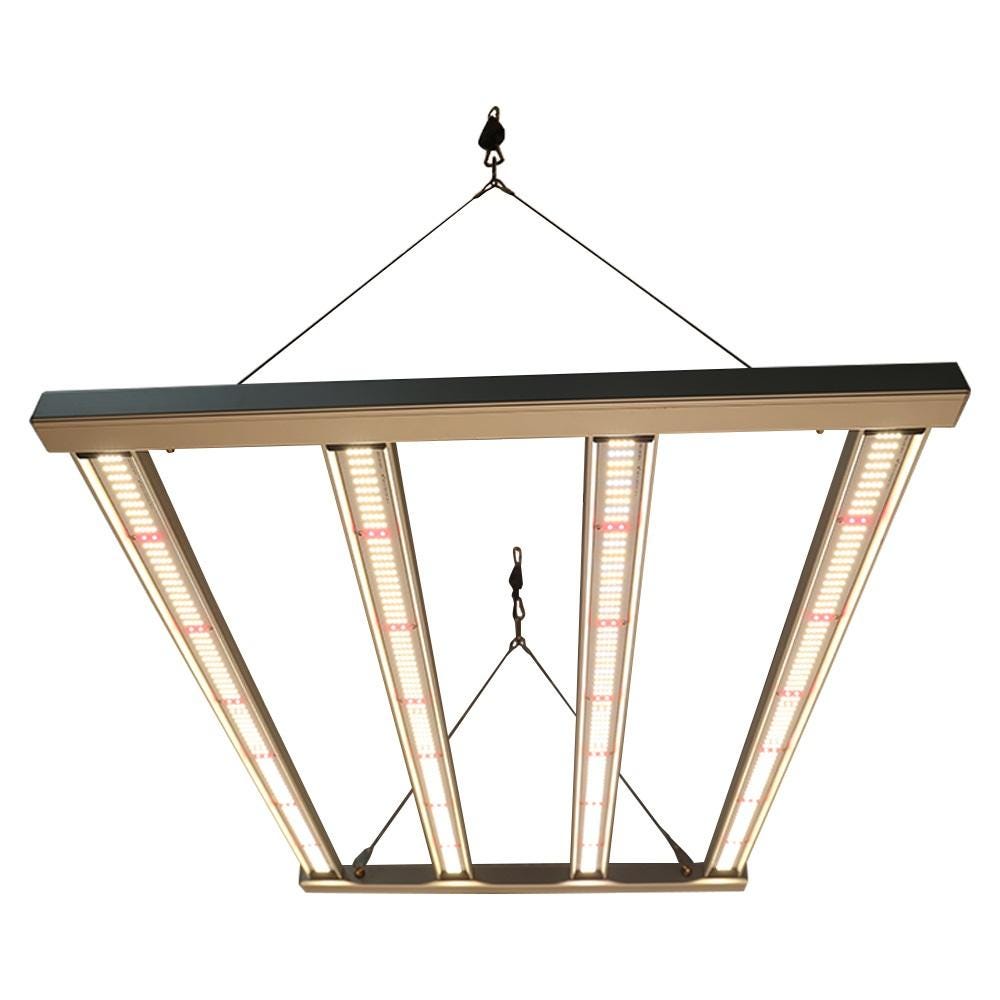
Features:
ECO Farm LED grow lights are equipped with upgraded LM301B chips and 4 high-efficiency aluminum bars to ensure higher PPE 2.4umol/J efficiency, better heat dissipation, and longer service life. Compared with old plant lights, the average PPFD is increased by 30%, and the yield and quality are increased by 50%. Covering 3x3–4x4 feet perfectly, the 320w LED grow light will help you achieve maximum quality and quantity. The 320 watt LED grow light is equipped with an external driver and dimmer, power cord. You can freely control and adjust the light intensity outside the planting tent without entering. Put it on hand, easy to operate. The driver outside the tent can reduce heat. 4 LED plant growth lights, each light bar is affixed with high-grade glue, waterproof and clean, not easy to be covered with dust.
Composed of full spectrum white 3000K 6500K and red 660nm, it is infinitely close to natural sunlight. The excellent spectrum is suitable for the whole stage of indoor plant growth. The full-spectrum LED plant growth light is equipped with 4 high-efficiency aluminum bars. Very suitable for led work to ensure long life.
Fanless zero noise and warranty-Fanless zero noise design, very quiet. LED plant growth light 320w is an ideal choice for greenhouses, planting tents, stents, vertical agriculture, etc.
Actual Power: 320W
Chip and Wavelength: LM301B3000K+6500K+96pcsM 660nm
Efficacy: 2.4umol/J
Input Voltage: 100 ~ 277v
Footprint: 3x3ft-4x4ft
IP Grade: IP65
Frequency: 50/60 Hz
Dimensions: 809 X 688 X 35mm
Weight: 9 kg
DLI Diode LED Toplighting Indoor Fixture for Indoor Plants
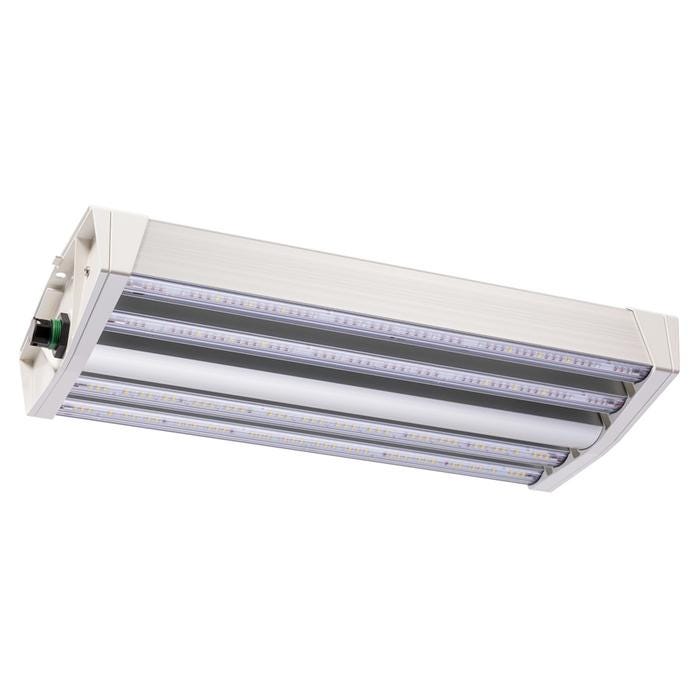
Features:
DLI’s new generation of high-efficiency LED TopLighting lamps provide outstanding performance with low power consumption.
DLI DIODE LED TopLighting lamps have excellent light distribution and optimal passive cooling of components. The LED spectrum is optimized by DLI for optimal growth on the bottom rostliny. By using a passive high cooling surface, the durability of the LED can be maintained.
Due to the unique light distribution, the Toplighting system will provide a high PAR PPF with an optimized coverage angle to ensure that the entire plant is activated by light. Toplighting lamps emit very little heat and do not require active cooling, which can minimize leaf burning. DLI Toplighting luminaires are designed to provide a high level of photosynthetic photon flux (PPF) value with the best angular vertical light uniformity. The unique design of the lens produces a highly uniform light distribution on the canopy. The fixing device is made of a slim waterproof device and is designed to be suspended above the plant canopy through an easy suspension system.
High Output — Up to 1000 µmol/s
IP65 Waterproof — Protected against water jets from any direction
Specifications:
Input Voltage: 220 ~ 400v
Input Voltage Range: ± 10%
Frequency: 50/60 Hz
Dimensions: 542 X 232 X 85mm (21.3 X 9.1 X 3.4 INCH)
Weight: 4.4 kg / 9.7 lbs
How high should LED grow lights be from the seedlings?
Different plants require more or less light and heat to grow properly, so it is highly important to determine the right formula for your indoor garden before planting any seeds. Generally speaking, the stronger the light, the further you’ll need to hang it from the seedlings to prevent them from burning or being damaged by too much heat.
A 1000-watt LED grow light should be hanged at a minimum of 15 inches from the plant. However, depending on the strength of the light, you shouldn’t place the light higher than 30 inches above the seedlings if you want them to still develop normally.
Smaller-sized lights like the 400-watt ones should stand around 20 inches above the seedlings without losing vitality. Keep in mind that this only applies to LED lights that don’t generate too much heat. By comparison, a 1000-watt HID grow light should be placed 16–31 inches away from the plant to prevent burning it.
Full Spectrum Grow Lights Buyer’s Guide
Buying the right full spectrum grow light is crucial to the well-being of your indoor plants. And not all of them are built in the same way. So, you need to keep in mind a few important features before moving on to choose a suitable light.
Switches
Generally, a full spectrum growth light provides sufficient light for all stages of plant growth. However, some of you might prefer products that let you control the type of light that the plants would get. These products feature switches that help in adjusting the different light modes suitable for different growth stages.
Cooling System
This is an important criterion to consider when you’re looking for a grow light. You should ensure that the light has an efficient heat dissipation system. While some products consist of mute fans, others have an aluminum heat sink that absorbs the extra heat. Note that some grow lights with fans may produce an annoying noise sometimes.
High Wattage
For providing your plants with good coverage and the ideal light output, you should find a spectrum light that offers a minimum of 300W. Though, a single plant or small crops can thrive with a light having a lower wattage.
Many of the LED lighting systems available currently offer a wattage going up to 1000W. Note that a wattage higher than this will need a much bigger room or grow tent and an air conditioning system as well.
Conclusion
When you’re growing indoors, you need to provide adequate ventilation in your grow room. An air-conditioned room is probably enough, but you might also choose to set up an oscillating fan to make sure the plants get fresh air and to help pollinate the flowers.
Pests are usually less of an issue when gardening inside, but if you do end up with a problem it can be frustrating to address. The most common problems you’ll encounter indoors are fungus gnats and white flies.
Good ventilation, careful watering, and sticky traps are good way to control these pests. Powdering your plants with DE is also helpful.
Overall, indoor gardening is not much different from growing outside. It just takes some work to make sure you’re keeping your plants happy under artificial light. Keep a close eye on your plants and watch their leaves for signs of stress like turning yellow or brown.
Best 100w LED Grow Light for Your Plants
July 01, 2021
You may be wondering: “Why should I use a 100W LED grow light?”
100 Watt LED grow light are one of the cheapest LED grow lights in the market. You should, however, not dismiss them due to their price. The lamps provide a similar or better light frequency than traditional grow lights of higher wattages. They are great options for cannabis growers with a minimal budget but still want to create an excellent growing environment for their plants.
How Do You Buy The Best 100W Led Grow Light?
Do you get stressed out thinking about shopping for a great 100W Led Grow Light? Do doubts keep creeping into your mind?
We’ve done the best we can with our thoughts and recommendations, but it’s still crucial that you do thorough research on your own for 100W Led Grow Light that you consider buying. Your questions might include the following:
Is it worth buying an 100W Led Grow Light?
What benefits are there with buying an 100W Led Grow Light?
What factors deserve consideration when shopping for an effective 100W Led Grow Light?
Why is it crucial to invest in any 100W Led Grow Light, much less the best one?
Which 100W Led Grow Light are good in the current market?
Where can you find information like this about 100W Led Grow Light?
We’re convinced that you likely have far more questions than just these regarding 100W Led Grow Light, and the only real way to satisfy your need for knowledge is to get information from as many reputable online sources as you possibly can.
There are many factors, including but not limited to the following:
Brand Value: Every brand of 100W Led Grow Light has a value all its own. Most brands offer some sort of unique selling proposition that’s supposed to bring something different to the table than their competitors.
Features: What bells and whistles matter for an 100W Led Grow Light?
Specifications: How powerful they are can be measured.
Product Value: This simply is how much bang for the buck you get from your 100W Led Grow Light.
Customer Ratings: Number ratings grade 100W Led Grow Light objectively.
Customer Reviews: Closely related to ratings, these paragraphs give you first-hand and detailed information from real-world users about their 100W Led Grow Light.
Product Quality: You don’t always get what you pay for with an 100W Led Grow Light, sometimes less, and sometimes more.
Product Reliability: How sturdy and durable an 100W Led Grow Light is should be an indication of how long it will work out for you.
ECO Farm G2 Series 100W UV&IR Quantum Board Grow Light
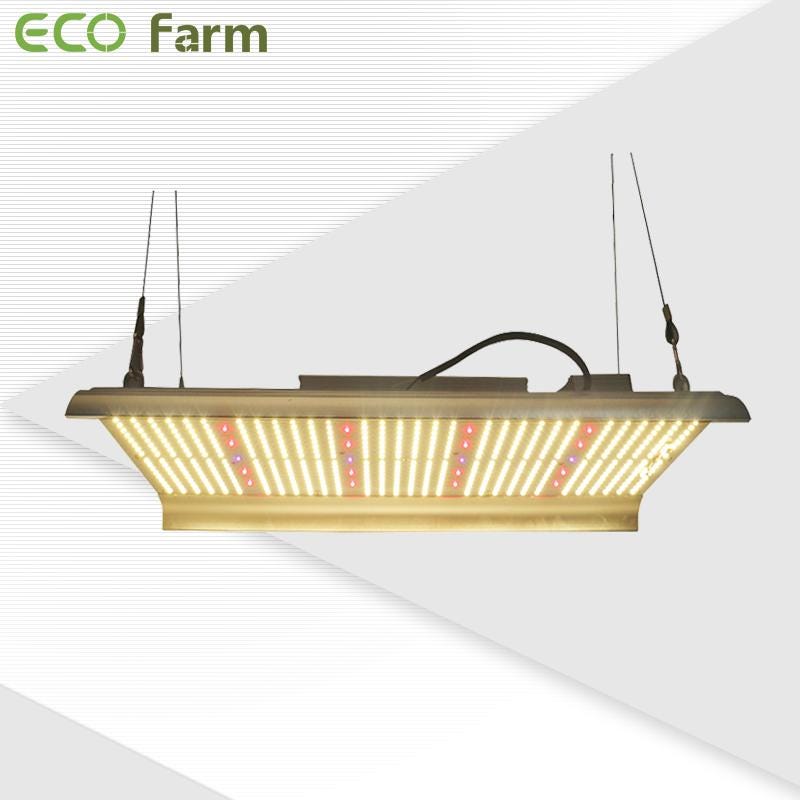
Features:
ECO Farm LED grow light utilizes the latest SMD LED technology, 2.5 umol/J high energy efficiency, providing strong light output and uniform roof penetration, so as to obtain higher output. Consumes only 100 watts, which increases your output by 30% compared to the old fuzzy LED lights
Applicable to all growth stages: excellent full spectrum-white, blue, red, infrared (3000K + 6500K + RED 660nm + IR 730nm + UV 395nm). 3000K diode provides more red light, 6500K provides more blue light. 660nm red and infrared lights are especially useful in bloom, which can speed up flowering time and increase yield. Turn the seeds into your own supply. The light looks quite natural, so it is helpful to accurately monitor plant health.
Applicable to all indoor planting environments: LED grow lights are suitable for indoor planting of various economic crops, greenhouses, gardening, agriculture, research centers, vegetable and flower hydroponic systems, etc.
Safe and silent: Waterproof power supply, no fan and no noise, provide you with a quiet environment.
Model: G2-Quantum 100
Maximum output: 2 g/W
PPF(umol/s): 250umol/s
Efficacy(umol/J):2.5umol/J
Dimension:9.45"*9.8"*3,46"
Draft Wattage: 100Watt
Input voltage: AC100–277V
Dimming: 0–10V/PWM
Spectrum: 3000K/3500K, 6500K, UV395nm, IR730nm, 660nm
Frequency: 50–60HZ
Spider Farmer New SF1000D Series Full Spectrum 100W LED Grow Light With Samsung Diodes
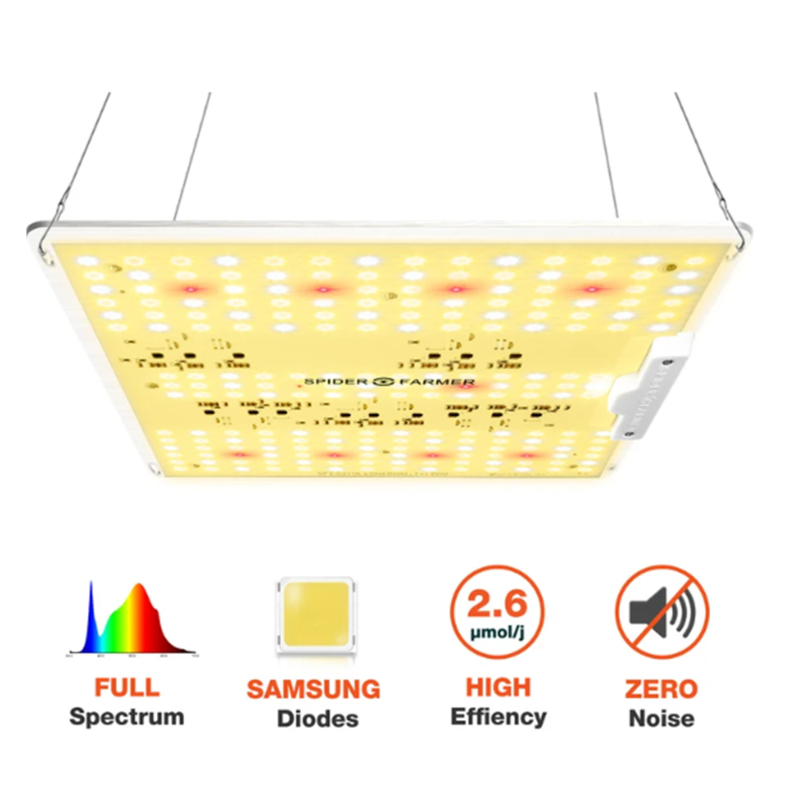
Features:
SF1000D used SAMSUNG Diodes-the highest light output LED available at present, high Energy Efficiency with 2.7 umol/J, delivers powerful light output and uniform canopy penetration to resulting maximum higher yields compared with other Led grow lights. Consuming only 100W, achieve better or comparable results than 200 watts HID with 50% less heat and power consumption.Veg footprint is 3 x 3 ft, Flowering footprint is 2 x 2 ft.
Full spectrum 660–665nm,3000K,5000K and IR, ideal for all growth stages (germination, clones or cuttings, mothers, vegetative, and flowering applications), turn your seeds into your own supply, produce beautiful high yielding plants.
Upgraded SF growing lights have a dimming knob and light switch. Sunlike full spectrum light ideal for all stages of growth.
Model: SF1000
Vegetable area: 3 x 3 feet
Flower area: 2 x 2 feet
Maximum output: 2.5 g/W
Humidity≤90%
Life: ≥50000 hours LED
Viewing angle: 90°-120°
Spectrum: 660nm, 30000 0K, 50000K and IR 760nm
Frequency: 50–60HZ
Input voltage: AC100–277V
Working temperature: -20°C ~ 46°C.
UNIT FARM UF2000 LED Grow Lights Full Spectrum Hydroponic Growing Light
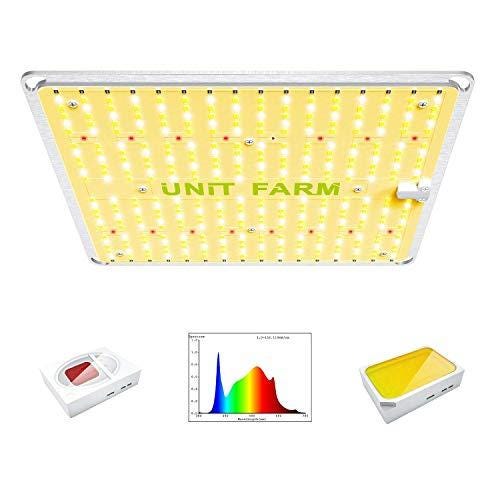
Features:
Efficient current found in thousands testing, Reduced electrical losses, for 110–240V. 368 LEDs only consumes 100 Watts. 2.7μmol/j high efficiency, Perfect for 2.5'x2.5' veg coverage at 20”, 2'x2' bloom coverage at 14”. Full Spectrum LED Grow Light Make Plants Stronger. Sunlike rich spectrum cover all growth stage. Composed of 100000 hours long lifespan Diodes from OSRAM. Include 3000K, 5000K, 660nm. Additional IR help for amazing bloom. Offer you 2.5g/W yield max. UF Thin LED panel for hang up as you want. Can fit into more different places and even be used as side lighting. Can be used for hydroponics and soil, for greenhouse, vertical farm, grow tent. Make your plants much more pretty.
Model: UF 2000
Number of LEDs:368pcs
LED Chips:OSRAM
Spectrum:660–665nm,730–740nm,2800–3000k,4800–5000k
Efficacy:2.7μmol/j
Input Power:100W±5%@AC120V
PPFD(18"):497μmol/m²/s
Input Voltage:AC100–240V
Amperage:1.223A@AC120V
Coverage:2.5'x2.5'
Dimensions:11"x10.2"x1.6"
Weight:3.04lbs
Buying Guide
Choosing the best LED grow lights for indoor plants is crucial to ensure their proper growth. If you choose something that provides too intense lighting, then your plants will burn and die out pretty soon. This is why you have to be careful when you want to get one. There are some certain considerations you need to look at while buying a growth lamp.
Available Space: You need to know the space you would like to cover with your LED lights. Each light comes with a maximum covered area; you have to understand the measurements as well. You need to measure the available height over the surface as well.
Durability: The durability of any product depends on the construction material and your use. Apart from that, aluminum or ceramic lights are quite non-conducive, which also contributes to durability.
Cooling System: LED lights are cooler than the HPS or HIS ones. Yet you need to have a high-quality cooling facility. You should check out the heat sink within the system. A perfect one will dissipate and move the heat away from the plants.
Plant Varieties: You have to decide which plant you want to grow inside your house. Different plants require different heat and light intensity. So, you have to find something elegant that will fulfill your gardening needs.
Color Spectrum: In the primary stage, plants require red and blue spectrum for growth. A good LED system includes red and blue lights, making a perfect blend for the growing plant.
But try to avoid the white LED as much as possible. Though white ones are very close to natural sunlight, they contain a green and yellow spectrum that can disturb photosynthesis.
Conclusion
The 100W LED grow light is a solution to cannabis growers who want to minimize their daily operational costs. The bulbs consume a small amount of power. However, it can deliver a light intensity of 100W to your plants.
If you have a big grow room, you can join the together to increase the power output. Depending on the number of bulbs you use, you can get a power of 300W, 600W, or even 1000W.
The bulbs are small, and therefore do not have fans, which makes them suitable for indoor use. You can use them for a very long time as they have long lifespans.
100W LED Grow lights have a lot to offer to cannabis farmers, regardless of the use. With the continual advancement in technology, price is no longer an issue. You can readily find LED grow lights to create a suitable environment for your cannabis plants at low costs. You can then consider using one or several 100W grow lamps depending on the size of your grow area. The lamp will help you create a suitable environment for your cannabis plants.
ECO Farm 4'' Ventilation Kit VS Spider Farmer Fan & Filter Bundle 4 Inch
June 30, 2021
Ventilation is a vital factor in your plant growth. By supplying fresh air from outside your grow tent, you provide CO2 for your plants, driving their photosynthesis. At the same time expelling the air inside will keep temperature and moisture build-up under control, preventing mold and mildew from forming on your plants’ leaves, inhibiting growth. Refreshing the air inside has the added benefit of removing strong odors. The following guide will show you what you need to know about setting up your ventilation system.
What Size Inline Fan do I Need?
There are various sizes of grow spaces, each requiring a different amount of airflow to ventilate them. Exchanging stale air inside with fresh air from the outside of your grow space is vital for optimal plant growth. This figure is measured in CFM or cubic feet per minute.
To find the amount of airflow needed for your grow space, first find its volume in cubic feet. Most grow tents’ measurements are given to you in inches, so convert your space’s dimensions from inches to feet. Then multiply its length by its width and height. This will equal your grow space’s volume, with the required airflow equal to this figure in cubic feet per minute, or CFM.
For example, a 48”x36”x72” grow tent converted to feet would be a 4’x3’x6’ grow tent. Multiplying the dimensions together would equal 72 ft3. Since a grow space’s volume is also the required CFM to ventilate it every minute, this grow tent’s base CFM is 72.
Below is a comparison of two ventilation kits, I hope it can be helpful to you.
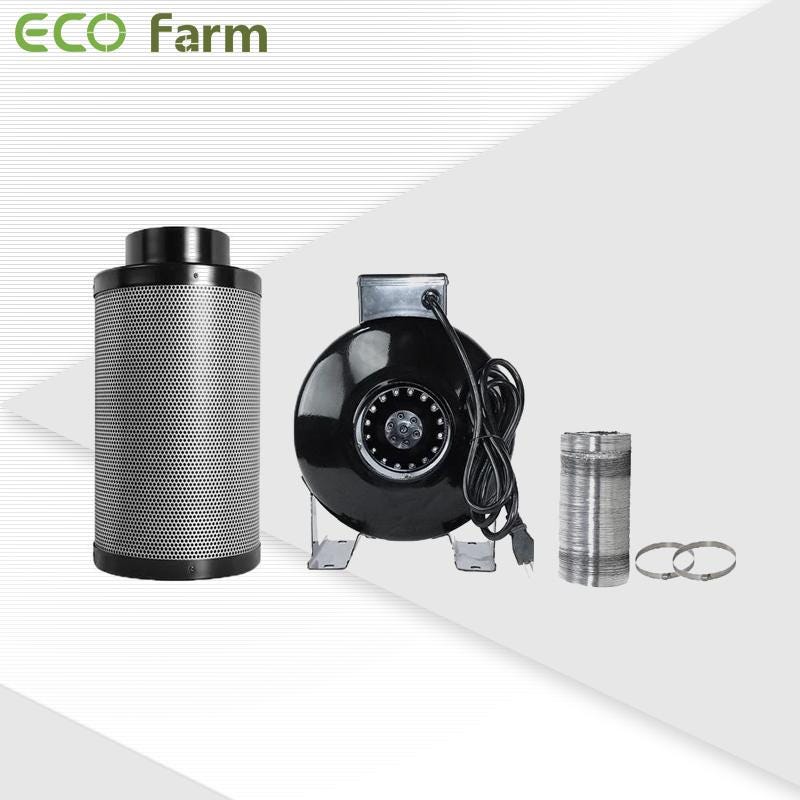
Features:
Eco-farm ventilation kit includes activated carbon filter, Inline fan, 4" duct fan, silver Flex duct and clamps.
Efficient ventilation: duct fan, size: 4 inches; voltage: 120V; current: 0.86A; frequency: 60Hz; power: 101W; fan speed is 2850RPM, air flow is 189CFM.
Effectively move air through the target location to achieve optimal ventilation
Air carbon filter: size: 4" flange pipe x 10" long. 1.5-inch carbon layer is stronger and has stronger absorption performance
Efficient design: Lightweight and compact fan takes up minimal space; very suitable for applications where large fans are not suitable. The efficient flow deflector function increases air flow while reducing noise output.
Multi-function: This ventilation combination can remove heat and eliminate bad odors in the planting tent, and it can solve the air delivery problem without major system rework or expenses.
Spider Farmer Fan & Filter Bundle 4 Inch
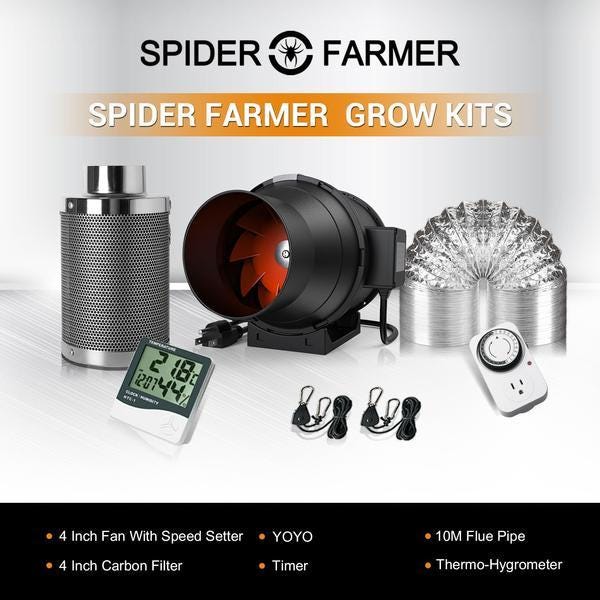
Features:
SPIDER FARMER Ventilation Kit 4-inch 200 CFM in-line duct fan, made of heavy-duty plastic shell, with excellent durability, hose dustproof and waterproof, inclined blades increase airflow by 40%, it only consumes 59 watts, but output 200 CFM ; Very low noise level, only 35DB.
High-performance carbon filter: It is composed of a durable metal filter housing and a stainless steel flange with a long service life; RC412 activated carbon is used to control and purify the odor, which helps to capture large particles and prolong the service life of the filter.
Flexible duct: The duct is made of high-quality aluminum and PVC, double-layer design; built-in steel wire to ensure durability; fully expanded length: 32FT;
Wide application: This air filter kit has a wide range of applications, you can use it in planting rooms, bathrooms, kitchens, greenhouses and other places.
Why Do You Need to Ventilate Your Grow Room?
So why do grow rooms and grow tents need to be ventilated? As it turns out, there are quite a few reasons.
Plants grown outdoors enjoy the mitigating effects of light breezes, sunshine, evaporation, and precipitation. Indoors, we substitute fans for breezes and evaporation, grow lights for sunshine, and watering systems for precipitation. What we often forget about is that outdoors, air circulates more naturally than in your grow room.
You need both a fan and an air filter to keep the air in your grow room fresh. Here’s why.
Remove Excess Heat
Grow lights emit heat. It might not seem like much to you, but a few degrees in temperature can mean the difference between a successful crop and a less successful one. Certain grow lights emit more heat than others, but all produce enough heat to merit ventilation.
Control Humidity
Humidity is another factor that can contribute to problems with indoor growing systems. Plants emit water vapor throughout the day which increases the humidity of your grow room. Uncontrolled humidity leads to poor growing conditions and can result in the development of pests and diseases.
A good ventilation system also wicks away some of the water released during transpiration, allowing your plants to absorb more water and pull up nutrients through their root systems, boosting growth.
Prevent Pests and Diseases
Air circulation helps prevents pests and diseases. Mold, powdery mildew, spider mites and fungus gnats prefer stagnant, humid conditions. Pests lay their eggs in damp topsoil, so having a fan to keep the surface layer of soil dry can slow their reproductive cycle, and a steady breeze makes it harder for them to establish themselves on your plants in the first place.
Control CO2
Plants need outside air for one very basic reason: CO2. Plants absorb CO2 throughout the day as part of their nutrient cycle. If your grow tent setup is sealed, this means that the level of CO2 in the room gradually decreases, limiting your plants’ growth. Ventilation brings in fresh air and fresh CO2 from outside and removes the old air from your grow room, boosting growth and yields.
Manage Wind Stress
Outdoor plants are constantly buffeted by the wind. This makes the stems of the plants stronger, which serves them well when the time comes to bear fruit. Stronger plants produce and grow better than weaker plants, which can break under the weight of their own yields.
So why do you need a grow room ventilation system? Let’s review. A good ventilation system:
Reduces the chances of diseases like mold and powdery mildew from developing
Helps protect your plants from pests like spider mites and fungus gnats
Helps you control the temperature and humidity of your grow room
Helps strengthen the stems of your plants.
Inline Fans Buyer’s Guide
Before you get your new fan, there are some things you should know, and certain features they possess which make them better. Without further ado:
The Size Of The Grow Area
Before anything else, you need to determine what size your area is. This is important because different sized fans will have different rates of air circulation, and you want optimal circulation in your room for the best results. Luckily, there is an easy formula to determine the ideal size for your room. All you have to do is multiply the height of the room by its width, length, and 1.25. It helps give you an idea how much air should be removed from the room.
The Heat Of The Lights
Since some lights generate more heat than other, you’ll need to determine what kinds you’re using and then see which type of fan corresponds to that. HID lights tend to heat up the place more quickly, so in that case, you’ll need a fan that can handle and remove the heat, for example.
Diameter Of The Fan
As you may have noticed, fans come in various sizes. It’s not always easy to choose the diameter you need. After all, there are those of 4” up to those of 16”. If you want a safe bet, get a 6” diameter fan. That’s because the most common indoor set up will be to accommodate that size perfectly. If that happens not to work for you, you can simply get a converter instead of an entirely new fan.
Conclusion
As you may already know, there are a few things that are essential for successful marijuana growth, and one of those is definitely inline fans. They keep things fresh and the air moving, which we all know is essential for quality photosynthesis. Because let’s face it, no matter how much better marijuana is from other plants, it’s still a plant.
Remember that if you take good care of your plants, they will take good care of you, too. It’s also much better that you’re growing your own stuff because you never know where the one you buy comes from or what might be in it. This is a much safer alternative, and it can prove to be cheaper, too.
How to Control Smells in The Grow Room
June 29, 2021
Have you ever been standing somewhere with no one around, and you catch a hint of marijuana smell in the breeze? Even if you couldn’t spot the source, you wouldn’t doubt what your nose told you.
One of the most appealing parts of cannabis is its pungent, unique smell. Unfortunately, that same delightful smell is instantly recognizable and can cause lots of trouble.
A grow room with flowering marijuana plants is a factory for that delicious tell-tale smell, and to protect your girls, you’ll have to make that smell a non-issue.
Today we’ll quickly get you up to speed the options available to neutralize smells made by your plants, and we’ll explain which methods are most effective.
There really aren’t a lot of options when it comes to stopping smells in the grow room. Either you find a way to “scrub” the smells out of the air, or you find a way to cover up the smell.
For a small grow with just 1 or 2 plants, you can usually get away with covering up the smell.
For a larger grow, you will likely need to scrub the air to make sure you’re not leaking any smells that might catch the attention of nosy neighbors.
Carbon Filters / Carbon Scrubbers
By far the best way to remove odours is with a carbon filter. They literally ‘scrub’ plant smells out of the air before it’s extracted.
For this reason, carbon filters should be part of every ventilation system.
Your extractor fan pulls air through your carbon filter. As this happens, air passes a bed of activated carbon. The VOCs that cause plant smells get trapped inside the pores of the activated carbon — they are adsorbed.
The trick is to make sure you get the right carbon filter.
Below are 3 very useful carbon filters, I hope to help you.
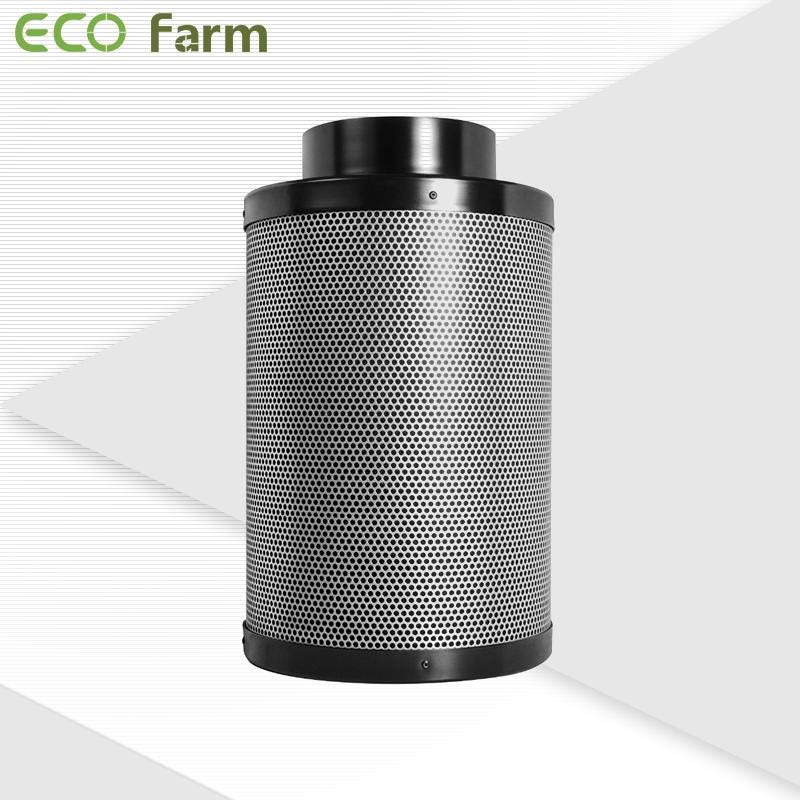
Features:
ECO Farm Carbon Filter cap is manufactured with high quality and durable aluminum for maximum strength and superior lasting effects. Extended service life. Up to 1.5 years in life expectancy.
Aluminum construction: Easy install with a simple plug-and-play feature that will keep you free from any unnecessary mess or hassle.
ECO Farm filter will not only soak up and eliminate some of the most undesirable to keep your space smelling clean and fresh, but also eliminate additional harmful and potentially ill-fating chemicals from the air you breathe.
CoolGrows 4 inch Air Carbon Filter
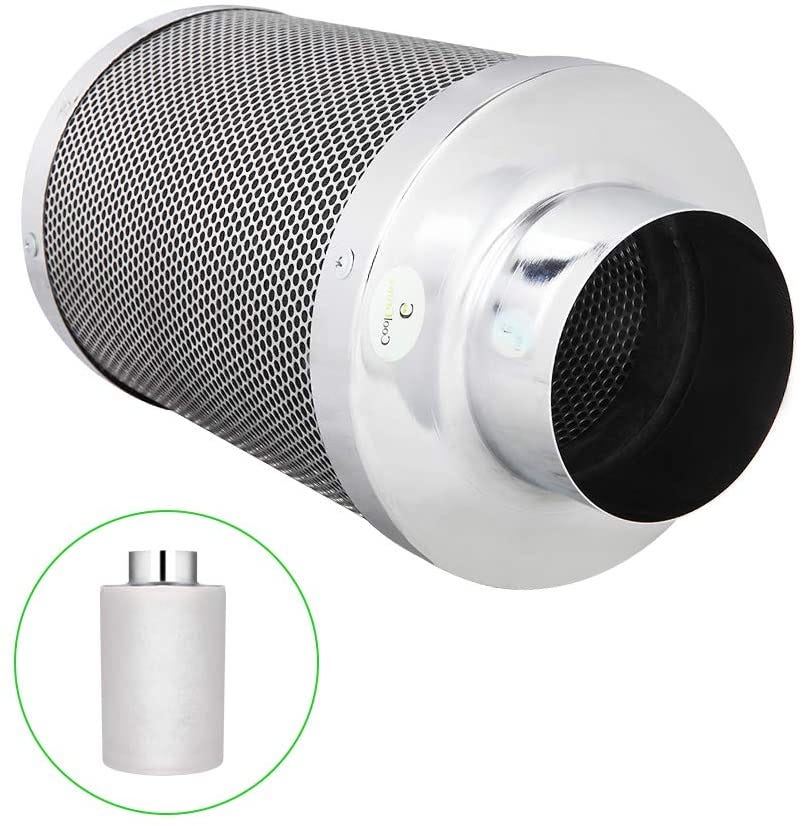
Features:
The carbon filter design has high durability and washing ability. Depending on the duration and enthusiasm of use, each filter can be used for up to 3 years. Our carbon is machine-packed during the manufacturing process to ensure that the escape of unfiltered air is minimized
Designed to eliminate odors and chemicals from growing tents and hydroponic rooms.
Using high-quality Australian charcoal, it has higher adsorption and longer service life.
Includes heavy-duty aluminum flange, galvanized steel mesh and cloth pre-filter.
Realize the maximum air flow through the intake and exhaust configuration.
VIVOSUN Air Carbon Filter for Grow Tent
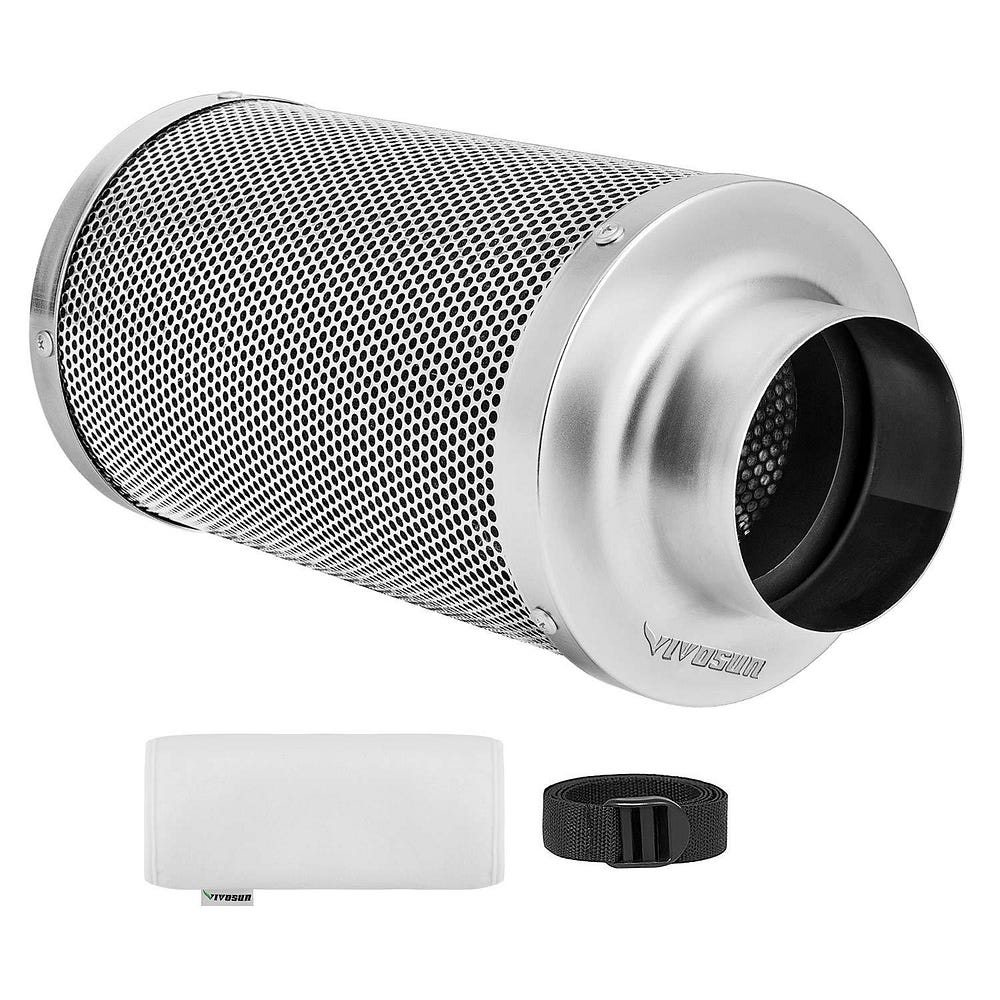
Features:
It has a powerful blower with a fan speed of 2300 RPM and an airflow of 190 CFM. Effectively pass air through your target location for optimal ventilation
High-quality carbon filter: 1050+ RC 48 Australian native charcoal bed. Size: 4" x 14"
Effective odor control: The carbon filter eliminates some of the most annoying odors, pungent odors and particles in indoor planting tents and hydroponic planting rooms.
STURDY DUCTING+ 2 Stainless steel clamp: Strong and flexible steel wire supports the heavy-duty three-layer pipe wall. The PET core is sandwiched in a fire-resistant aluminum layer and can withstand temperatures from -22 to 266 degrees Fahrenheit.
In addition to carbon filters, there are the following methods to effectively control odors.
Negative Pressure
Negative pressure is the best pressure for a growroom. This means there is more air leaving the growroom than there is being drawn in. The benefits of negative pressure are that temperature and humidity are easier to control and growroom odor is reduced.
To maintain negative pressure you should use a less powerful intake fan so that you are drawing in 20 percent less air than you are extracting, otherwise your tent can become too full of smelly, unfiltered air which can then start seeping out of zippers and seams before it passes through your carbon filter.
Controlling Heat and Humidity in Flowering
Your cannabis plants are at their smelliest during flowering. Firstly, because this is when the buds are ripening, and all the oils and terpenes are at their highest levels. Secondly, the increase in heat and possible humidity during flower will emphasize this even more. Your humidity level should be kept low during flowering anyway in order to avoid rot, fungus, and mold, but this is another reason to keep it low as smells intensify under humid conditions. Air circulation fans will also help prevent hot, humid spots around your plants.
Here’s what you should look out for:
Carbon Bed
The deeper the carbon bed, the more activated carbon there is. Filters with deeper beds tend to last longer.
Spigot Size
To ensure your fan and filter can be connected, match your spigot size to the diameter of your fan. If they don’t match, you can use a reducer. BUT the chances are if your carbon filter spigot is too small, it’s not suitable for the air flow of your fan.
Air Flow
Air needs to be in contact with the carbon in your filter long enough to remove odours. To make sure this happens, the air flow rate of your carbon filter and fan need to match.
Don’t forget to maintain your filters. It’s important that you:
Replace pre-filter / carbon filter sleeves
Pre-filters and filter sleeves stop dust getting into your carbon filter — dust that would otherwise reduce the life of your carbon. To keep dust out, you’ll need to replace them every 3–6 months.
Replace carbon filters when needed
This will normally be every 9 months — 2 years, depending on which filter you buy.
Do not humidify with unfiltered water
Unfiltered water contains minerals. When used in a humidifier, these minerals can clog up carbon filters and reduce their life. To prevent this, always use RO water with your humidifiers.
Conclusion
It is important to remember that as pleasant as growing cannabis is, not everyone shares the same opinion.
Using any of the above-listed solutions, either by themselves or combined, does not cost a lot when considering the benefit they provide to the whole process of indoor cannabis growing and the peace of mind that comes when the room is scent-proofed.
Also, most of these methods are intended for large scale indoor grows. If you’re growing a single plant or only a handful, then the odor won’t be worse than smoking a joint in your living room, and these methods of odor control may be overkill for you.
These solutions, while keeping the odor levels low, also focus on maintaining optimum growth conditions for the plants which are an obvious benefit in the long-term.
ECO Farm Waterproof LM301B 450W Quantum Board VS Horticulture Lighting Group HLG 600 BSpec
June 28, 2021
If you want your indoor plants to grow well, be healthy and lush even when grown indoors, you need to mimic the natural conditions as faithfully as possible. That’s why you need to make sure to water them regularly and adjust the pH level according to the plants’ needs.
Other than specific soil and water requirements, having high-quality grow lights is also super important. Sunlight is crucial for plants because it’s necessary for photosynthesis. On average, plants, need around 12 hours of light every day, and sometimes that’s not possible, especially if you live in an area that doesn’t get a lot of sunlight.
That’s why you should invest in indoor plant grow lights, and you need to know which ones are the best ones for your indoor plants in order to make the right choice. Also, you need to learn what type of light is best for growing plants indoors.
What exactly is full spectrum LED grow light and why is it important?
Light Spectrum
First, you must understand the light spectrum, or color wavelengths. It is the range of light colors we see or didn’t see. Visible light that our eyes can see is between 380–740 nanometers. And similarly, the leaves of plants also enjoy these visible wavelength; the chlorophyll uses these light to manufacture food. The green light is an exception. Because chlorophyll only reflects green and they don’t absorb it, that explains why plants’ leaves are green. You can read more about these in this article.
So for the most parts, plants respond to the blue and red colors very well. These are the two most important wavelengths that plants need during their growth. Basically, plants need blue light for their vegetative phase and red light for the flowering period.
Understanding that, many grow light manufacturers have made it possible to produce the light colors plants need with their LEDs light. Many modern LED grow lights have a programmable setting to produce different color wavelengths. By this, you can control the type of lights at the different ratios for plants at different stages of growth in their life. These types of LED lights with a very wide or full range of color wavelengths are called full-spectrum LED grow lights.
So two of the most important criteria that affect plant growth are light intensity (or the power of light output), and light colors (color wavelengths). For light intensity, you can opt for the powerful light, but for light colors, you should choose one with a wide range of color wavelength (or full spectrum).
The following is a comparison of two LED lights, I hope it can help you.
ECO Farm Waterproof LM301B 110W/220W/450W/600W Quantum Board
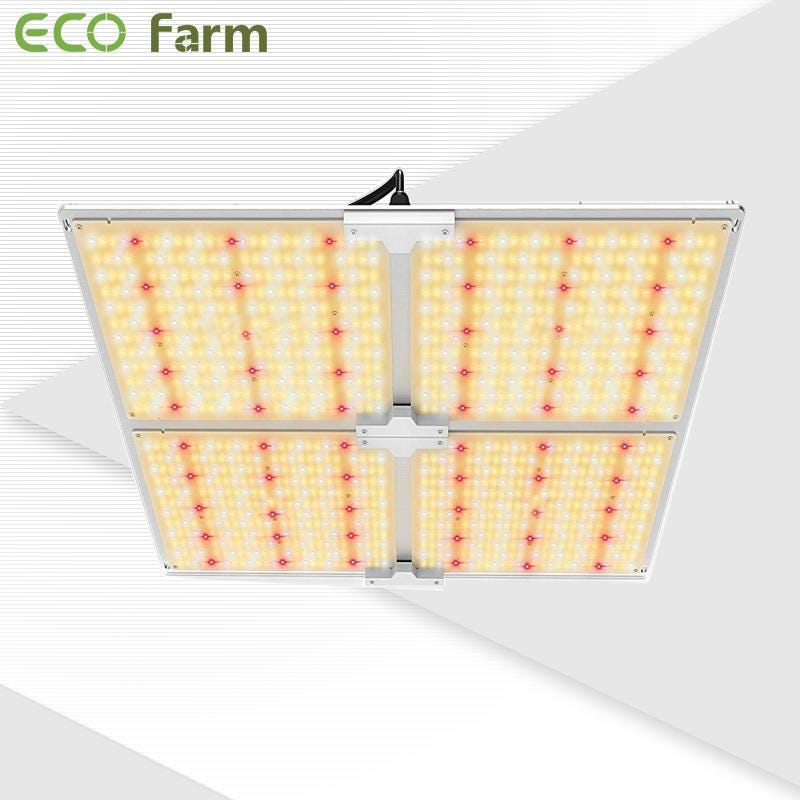
Features:
The ECO Farm LED grow light adopts the design of full spectrum (380nm-800nm, 3000K, 5000K), red light 660nm and IR 750nm, provides everything the plants need under natural sunlight, and promotes healthier and more balanced plant growth by stimulating photosynthesis .
The IP65 waterproof rating makes this plant light suitable for more planting environments, especially hydroponics, greenhouse cultivation, commercial cultivation projects, etc. You will be able to reduce the cost of horticultural lighting systems.
High-efficiency white light board with Samsung LM301B diode, high efficiency 2.7 μmol/J. The full spectrum of white light allows optimal canopy penetration and easy viewing.
No fan means zero noise. Large solid aluminum radiator, high-quality cable protection cover, waterproof LED, high safety performance and dimmable MEAN WELL driver.
Horticulture Lighting Group HLG 600 BSpec
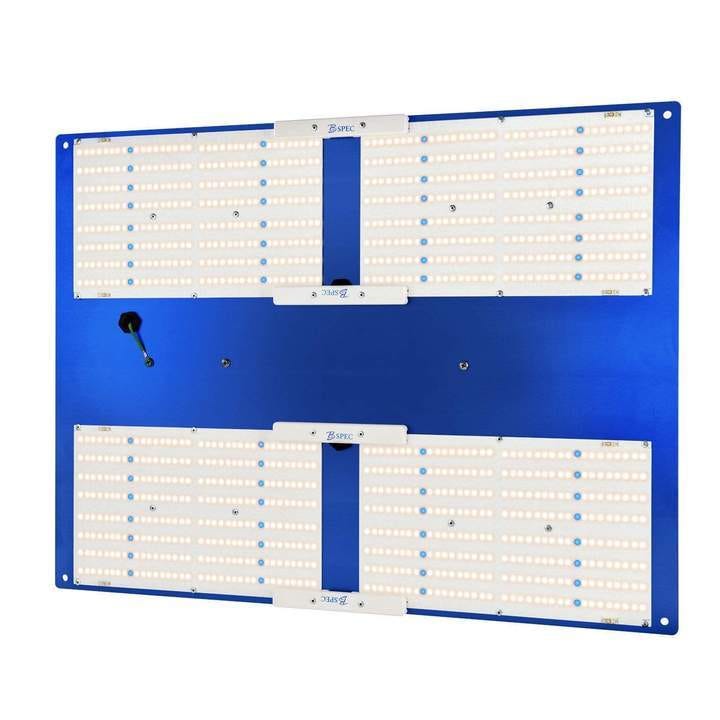
Featutres:
The Horticulture Lighting HLG600 Bspec commercial indoor gardening LED plant growth light is designed to replace single-ended 1000 watt HID. Each HLG 600 uses 4 customized full-spectrum high-efficiency white light quantum panels in conjunction with Samsung LM301H and blue 470nm to enhance plant growth. This unit is dimmable.
Auto-sensing Inventronics power supply is suitable for 120VAC and 240VAC and 277VAC; 600W power consumption (dimmable to 60W)
Vegetable footprint is 162.44 cm x 172.44 cm (recommended for vegetables only) Total output is 1446 PPF; PAR efficiency: 2.4 umol/j; reliable passive cooling design and ETL certification
Why Do You Need The Best LED Grow Lights?
Having a LED grow light set up is essential for various reasons. There are a lot of approaches to get light to your plants, yet how would you realize that it is the most proficient way? How might you realize that you aren’t really overheating your plants trying to direct more light into them and increment your yield?
The reality remains that LED lights are the most productive grow lights that are accessible. To start, LED grow lights moderate 75% more power than customary grow lights. By utilizing less power, you will spend less cash on power bills and hence have significantly more cash remaining for getting a charge out of your rewards for all the hard work, as opposed to spending its dominant part running the grow task itself. Vital too is that the best LED grow lights utilize particular wavelengths of light that are required the most by your plants. Conventional grow lights shoot your plants with light and subsequently a significant part of the light is squandered.
LED lights, then again, utilize just blue and red wavelengths to give your plants everything that they require without wasting power and light on things that aren’t successful. There are LEDs that component either both, or special case, which makes it conceivable to practice and tailor your lighting to your plant’s needs.
LED grow lights are likewise considerably cooler to some extent because of the diminishment of power utilization. The issue with numerous grow lights is the warmth that they deliver, which makes you burn through cash on different parts of your grow task too.
The hotter your grow room stays, the more air you should move through the room, and the more consideration you should pay to the temperature constantly. That likewise implies that LED grow lights are substantially easier on the environment. With the consideration being brought to ecological concerns, a worldwide temperature alteration, and the eventual fate of the world, it is anything but difficult to perceive any reason why individuals would probably incline toward an all the more environment friendly alternative.
That is the place LED grow lights succeed. The gigantic lessening in CO2 emanations, notwithstanding power utilization, implies that the earth will be appreciative. LED grow lights additionally don’t need to be discarded in a specific way like HPS lighting frameworks do.
Grow lights containing mercury should be professionally discarded in a way that requires extraordinary consideration following a few years because of the shorter time span of usability. LED grow lights can keep going quite a while and after that be discarded after very nearly ten years of utilization without worrying about hurting the earth simultaneously. The last thing that emerges about LED grow lights is the way that they don’t need to be supplanted all the time. Numerous grow lights that individuals utilize are supplanted inside a short measure of time since they destroy decently fast.
In correlation, the majority of the best LED grow lights can keep going for more than 50,000 hours, which means they should be supplanted following 7–8 years at the most punctual. The cost can dismiss a few people from utilizing them, yet once the length of their life is considered it is anything but difficult to perceive how much cash can really be spared after some time.
What to Look for in a Good Grow Light for Indoor Plants
If you’ve ever done research when wanting to buy grow lights for your indoor plants, you probably saw that there’s a variety of choice of both types and brands. How do you choose the one to buy then? Well, as long as you keep in mind the essential features that the plant lamp you purchase should have in order to keep your indoor plants healthy, you’re safe. So, without further ado, let’s talk about the crucial features to have in mind when choosing.
1. The type of light
There are two types of grow lights that are both good for indoor plants — LED and fluorescent.
The choice will depend on your preferences and needs. While both of them will help your indoor plants grow healthy and lush during every growth stage, LED lights are more energy-efficient. Even though modern fluorescent grow lights save more energy than in the past, LED will still use less electric power because it only produces blue and red light that your plants need.
That’s why fluorescent lights will be white, and you’ll be able to use them indoors without problems because they won’t be unpleasant to look at if your plants are close to the everyday rooms in your home. When it comes to LED lights, they do produce purple light so they can be a bit hard to look at and that’s why they are the better option in closed growing tents or rooms that you use only for the plants.
2. Color spectrum
Depending on the growth stage of your indoor plants, they will need a different color to produce energy and grow, so you should use grow lights according to that fact.
However, it’s always better to have grow lights that emit full-color spectrum because those are versatile and can be used for every stage and many different plants.
3. Material
If you want to be sure you’ve bought good-quality grow lights, you should choose those that are made of high-quality, sturdy material, preferably stainless steel.
Why? Because grow tents and area around plants, in general, can be humid. Since the water will constantly be close to the grow lights, they should be water-resistant in order to last you for a long time.
4. Weight
Even though the material should be sturdy, the grow lights you buy shouldn’t be too heavy, especially if you need to hang them. Lightweight grow lights will be easier to adjust, and there won’t be any risk of them falling on the plants.
5. Dimming levels
As you’ve already noticed, some models offer the possibility to choose between different lighting intensities, which can also be very useful.
This feature offers a lot of versatility and allows you to use the same grow light for different kinds of plants and stages of the same plant. So, if it’s possible, invest in the model that offers this solution.
6. Timer
If you travel often or spend a lot of time outside your home in general, you should opt for grow lights that have an integrated timer, or at least those that can be connected to the timer you own or want to buy.
The timer will allow you to choose the intervals in which your plants will receive light. Usually, you can set them up to automatically turn on and off every 3, 6 or 12 hours, and some of them can be programmed to do that every day at the same time. Pretty convenient, right?
7. Easiness of setup
It’s always better to choose a simple product, right? With that in mind, purchase a grow light that will be easy to install, use, and even bring with you if necessary.
Also, it’s very convenient to purchase grow lights that have the option of being connected with the daisy chain cables because then you will need only one power outlet for multiple grow lights — mess-free installation!
8. Adjustability
When choosing the right grow light among all of the choices on the market, it’s always better to look for those that can be easily adjustable. This is important because every plant will require a different distance from the source of light.
And not only different plants but also the same plant in various stages of growth. That’s why, if you plan on hanging the lights above the plants, you should be able to adjust them when needed.
Conclusion
Quantum Led grow lights are not as game changing as the LED grow lights were, but it is a step forward in the technology. While quantum led grow lights may not be the best choice for every application i.e.to increase harvest in indoor growing, but still these grow lights are useful for other large number of applications.
Best 400W LED Grow Lights For Your Indoor Growing
June 26, 2021
65% of the indoor growers regret bad grow light setup, resulting in terrible yield.
Hence, lightening up those notorious grow plants is a big nut to crack! Which, maybe bothering you up lately, and brought you to this web page.
LEDs are no doubt, a way better source of grow light from HIDs, HPSs, MHs, and so on. The best LED grow light comes with a fine blend of full-spectrum coverage, cost-effectiveness, and low heat emission. In case it gives you a promise of 50k+ hours of durability, that’s a jackpot!
But how on earth you’re going to pick up the right LED grow light? There’re 100s of them in the market, right?
That’s where we’ve taken over on behalf of you. We’ve hand-picked 154 of models in the market, and let real growers sort it out. Finally, a list of top 3 LED grow lights is there, with features and specs broken down in bite-size chunks.
What Are LED Grow Lights And Why Would You Want One?
LED grow lights are relative newcomers to the world of indoor horticulture, but they offer certain big advantages over the older styles of grow lights people have used traditionally.
The first big advantage is that LED lights run much cooler than more old-fashioned grow lights. While plants need a certain level of warmth to survive and thrive, old-style lights simply give off too much heat — much more than plants can absorb. This equates to wasted energy.
With LEDs, you are just creating the light that plants need without the extra heat, making them much more efficient.
As a result, LEDs are also much cheaper to run. If you run old-style grow lights that are constantly wasted energy as heat, you are using electricity for nothing. For this reason, LED lights can be an investment since they can end up saving you money on your electricity bill.
They have one other distinct advantage, too.
Light is emitted in a whole range of wavelengths, but not all light is useful to plants. The parts of the spectrum that are particularly important to plants are the red and blue wavelengths.
With many modern LED grow lights, they have been specially engineered to give out maximum amounts of light at exactly these wavelengths, essentially tuning them to the plants’ needs.
With regular grow lights, this isn’t possible, and the plants just have to take what they can from the full spectrum without being fed a special “diet” of red and blue.
ECO Farm Newest Samsung LM301B 460W Quantum Board with Daisy Chain
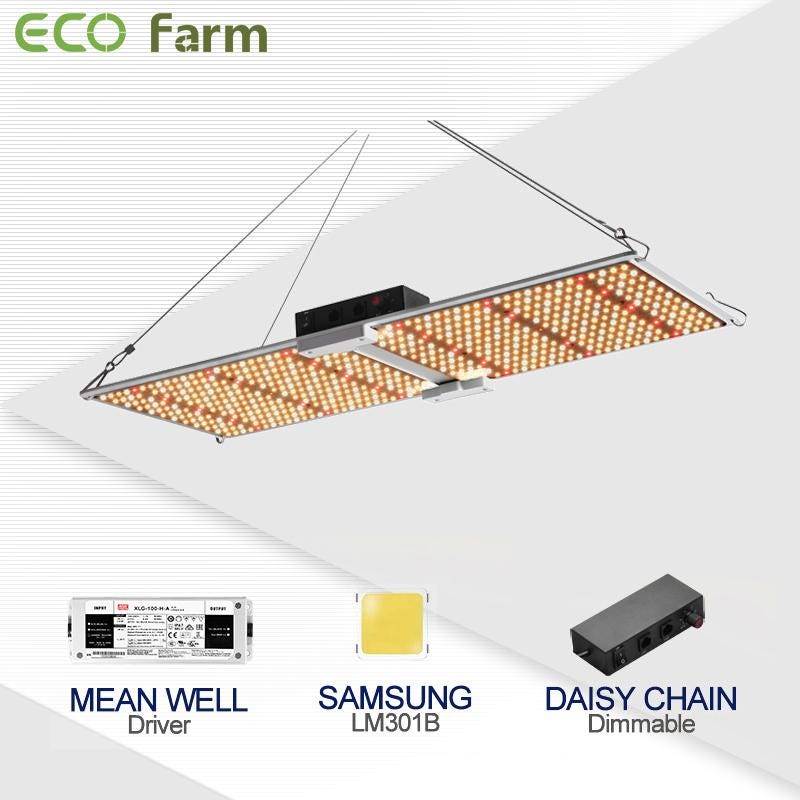
Features:
ECO Farm LED grow lights use the latest high-quality LED technology-Samsung LM301B diodes, 2.7 umol/J high-efficiency LEDs, increase crop yields, save operating costs, generate more usable lighting per watt, and provide better awnings. Power.
High-quality full-spectrum and flexible dimmer: composed of 3 white, blue, red and IR (3000K, 660nm, IR 760nm and UV 395nm), to provide your plants with high-quality full-spectrum LED growth lights. Red and infrared lights are particularly useful when they are in full bloom, which can speed up the flowering time and increase high yields to obtain an ideal harvest.
Quiet operation and sturdy structure: no fan and zero noise. The average WELL driver with high safety performance is adopted to achieve high Par output and longer life span, which can accelerate the growth process of plants, increase yield, and save energy costs.
Grow-It-LED Excalibur King Series
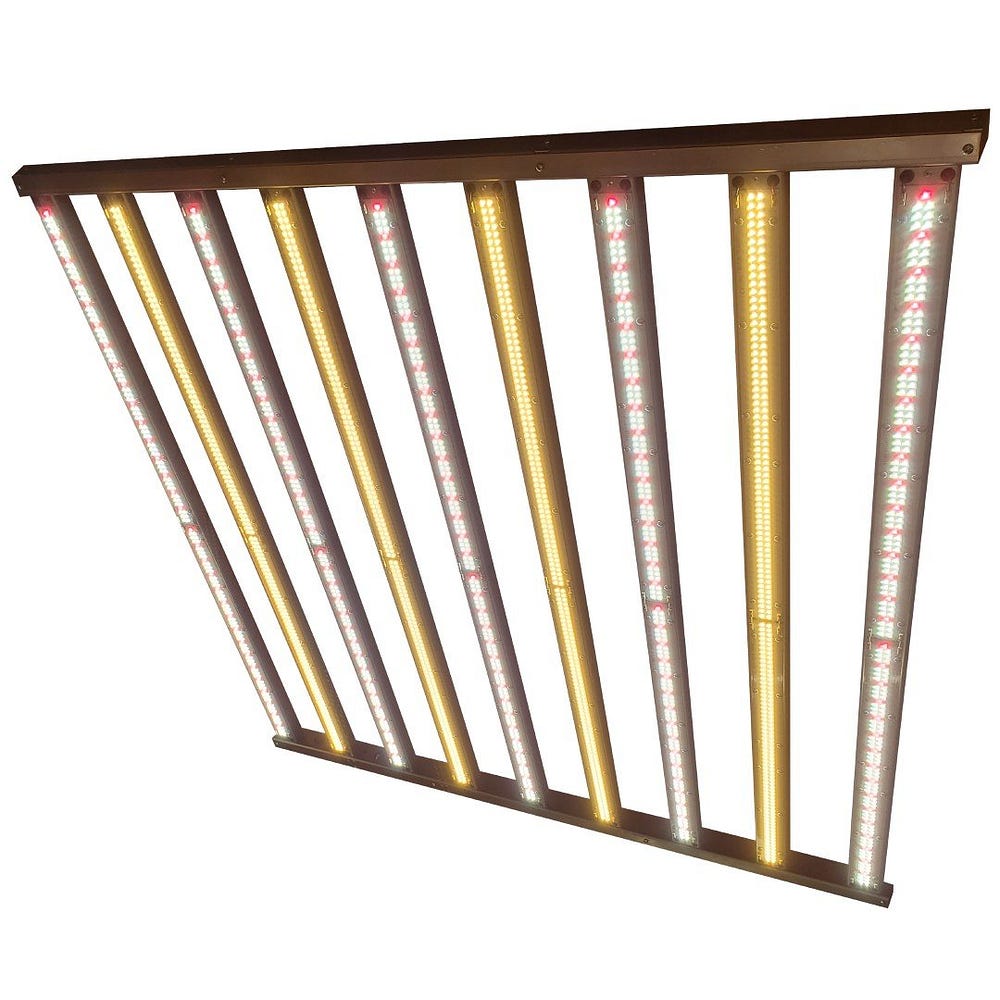
Features:
Designed specifically for 1000w DE HPS alternatives. They designed this system to surpass the competition at a very competitive price
Provide a variety of spectrum packages at different price points to provide tiered pricing and spectrum options. Due to the passive cooling design, the fixture design can provide completely silent operation
Their most expensive ultraviolet to infrared growth lamp uses new technology to use growth technologies such as the Emerson effect to speed up flowering time
Each LED is under-driven to improve efficiency and service life. The system is expected to reach 100,000 hours
Enlite Sulis Series 400W Vegetative Light
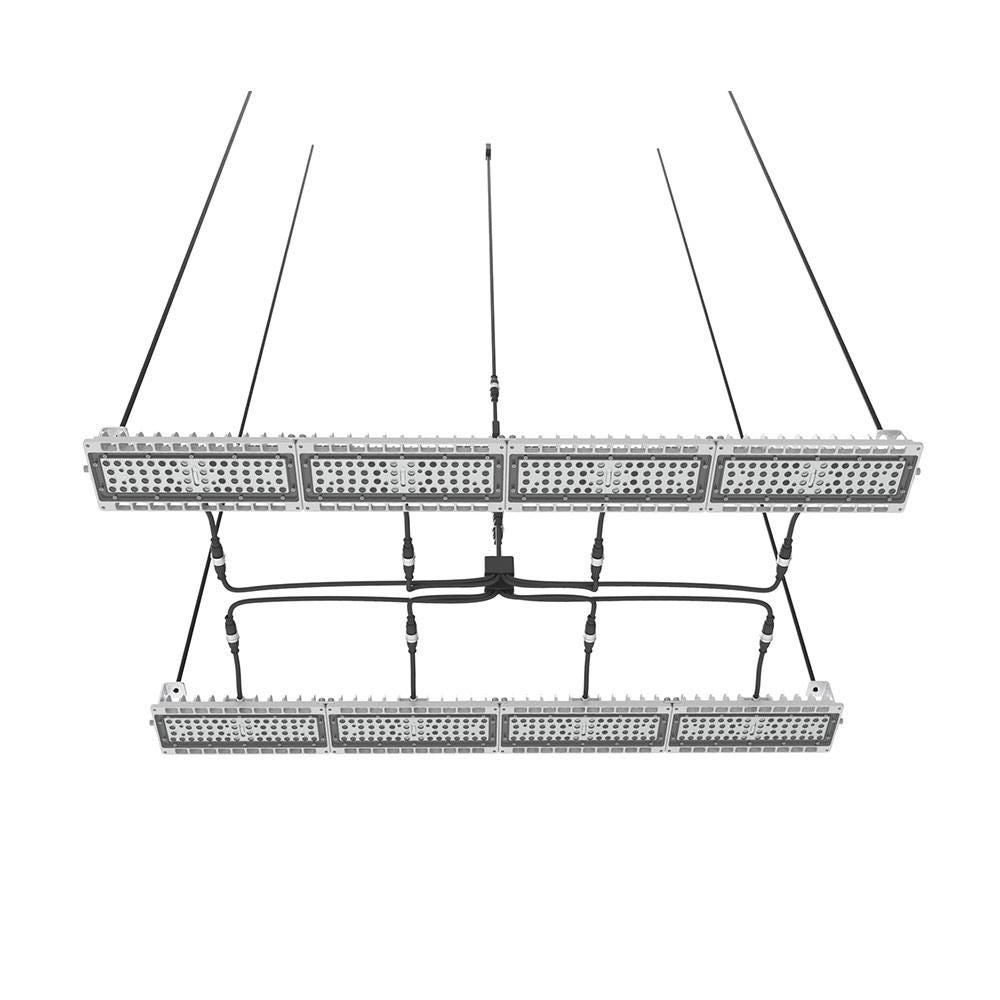
Features:
Excellent Heat Dissipation System,With a self-designed special structure heat dissipation system, this Sulis series grow light can keep itself in a much lower working temperature comparing to the other grow lights. This unique design can not only extend the light lifespan, but brings less harmless to the canopies. Lower heat release, better grow atmosphere.
Due to the smart modular design, you can assemble this Sulis series grow light into any shape. Bring this light to your farm with more beautiful, more creative, more practical functions. Believe it will bring you a little bit more happiness as it will bring dearly enough light to your plants.
IP66 waterproof design, you no longer have to worry about water mist entering the light, which makes the Sulis series lights have a longer service life and no need to do so much maintenance (changing the bulbs or so) as the other lights do.
Does Your LED Grow Light Provide a High PAR Value Rating?
Pay close attention to manufacturers’ recommended growing areas or you will run into trouble. In my tents I like to provide 3 square feet of space between each plant, that’s more than the average of 2 square feet. That means for every 36” square area I use for a plant the unit needs to be able to bloom and “veg” the same space.
You can “veg” a lot more plants under a light, but you need to be able to flower those plants and grow lights produce the most power directly under the unit. The actual blooming footprint is normally 20 to 25% smaller than the “Veg” footprint.
To grow and flower cannabis correctly you should provide the plant with 30 to 40 watts of light per square foot. So if your LED is 250 Watts you can have about 6 plants under it. This is a very simple way of looking at this situation since LED light isn’t really measured in Watts but in Par. Since lights are packaged with Watt ratings instead of PAR in most cases I choose to break it down this way for the readers.
Brand/Budget/Price: The more I test LED grow lights the more I’m surprised by the results I get from different manufacturers and price points. I recently tested a high-end brand light worth $799 USD against what most people would consider a cheap consumer-level brand that cost just $249 USD and the cheap brand kicked the big brand’s ass all the way around my grow tent.
You need to look at more than the price and the brand to determine the best LED grow light. You need to test it in a closed environment, growing cannabis to term and that’s just not possible for most people. That’s why you need to read professional reviews to know your way around.
Just don’t ever believe the hype unless it’s coming from actual users or professional independent reviews. Anything the manufacturer tells you will be incorrect and just marketing spin.
There are amazing lights that beginners can afford to start out with and there are high-end units that are worth every dollar you invest in them. Don’t get caught up in brand loyalty or thinking you must spend heavy to grow at home.
Light Spectrum: The kind of light a LED produces can be very different from one unit or maker to another. First off when we talk about the spectrum, we are talking about the light spectrums between 280 nm (UV) and 1200 nm (infrared). Each LED grow light is different but one thing they all have in common is that they all cover at least a small portion of the usable light spectrum.
Generally, cheaper lights produce fewer light spectrums. For example, the Mars Hydro II Pro which is a cheaper unit produces light between 390 nm and 690 nm and peaks in the blue and red spectrums. This is what gives the familiar purple haze that people are used to seeing.
More expensive units produce more light spectrums and intensity and, in many cases, produce much more product due to the inclusion of more plant usable light. These wideband lights produce light in every spectrum including UR and IR which are both helpful to the growth of cannabis plants.
Electricity Usage and Efficiency: LEDs or light-emitting diodes are 40% more efficient at converting electricity into usable energy than a traditional incandescent bulb. Bulbs are very wasteful and much of the energy is wasted as heat.
LED’s run much cooler then any HID light because they are efficient at converting power to light. What does this mean to you? It means that with each grow you saves 40% of your hydro bill, again and again. That’s why LED makes sense not to mention that it has an operational life of over 100,000 hours.
Light Control: Believe it or not there are many ways you can control your LED. When growing cannabis photoperiods are very important to the plants in determining when they begin to flower. Generally, I run my lights 24/7 in “veg” and then switch to 12/12 via a plugin timer.
Many traditional LED panels tend to provide a “veg” switch and a “bloom” switch which not only can control the time of photo exposure but also change the light spectrum to a more suitable mixture of light.
The last option is LEDs that contain a built-in timer. This is a nice to have feature but is easily replicated with a cheap plug timer.
Advances in LED grow lights Have Maximized PAR Value and Light Coverage
With the advances in LED grow lights, the time has come for this option of grow light. LED has transformed the way smaller growers can produce increased amounts of cannabis in smaller spaces. HPS lighting required more space due to the massive heat generated and required a proper ventilation system to dissipate all that heat.
That’s no longer true for those using LED lighting.
LED’s can function in a wide area of the light spectrum which means that your plants receive more usable energy from the light generated. LED is able to be adjusted to match the needs of your plants during the different life cycles of your grow.
The greatest change in LED lighting is that you will use less than 50% of the energy required to grow your cannabis while providing your plants with a better usable wavelength that promote better faster growth.
Checklist Before Buying a LED Grow Light
- Space Matters: Considering your space is a thing you should certainly do before buying a growing light. Space is a big factor. When choosing an LED growing light, its size and installation space must be properly checked in order to avoid the distorted growth of the indoor growing plant. Besides, when light is set too close to the growing plant, it will get destroyed and burnt. So, it is recommended to read the instruction manual to enable you to know the required distance of the light from the plant. Space and light’s size is key
- Quality: product quality is very crucial as it helps determine efficiency. So, before selecting a product always take note of its quality. Some of those things to consider while choosing the best grow light are its appearance, durability, and internal and external hitting issues.
- Pricing: price is a factor when it comes to getting a working and long-lasting LED grow light. Don’t need to bother with the price if you need quality. A good LED grows light for the large-scale purpose should be within the range of $500. However, for personal (hobby) use, you should spend $150–300.
- Appearance: The look of the product always gives the first impression and either calls for an attraction or repels. When a product isn’t eye-catching then no matter how beneficial it’s working, the grow light might not attract you. It is important to consider the out-look of Led grows light before buying.
- Durability: Durability is an indispensable factor to consider when buying an LED grow light. Knowing that a growing light is a big venture, which means you must embark on a sturdy product for greater efficiency and yield of your indoor growing plants. You can use a durable product for a long-living time. So, when selecting a grow light, take note of the longevity of it.
- Lifetime of LED: This is another important factor to know. Before selecting the best LED growing light for an indoor garden or greenhouse, the lifespan of the LED bulbs contained in the growing light must be properly checked and guaranteed.
Conclusion
One of the factors that you need to consider when choosing a grow light to use should be the wattage of the unit. Your grow light wattage will determine the size of your coverage area and how the light will affect the various cannabis grow stages.
A 400w grow light is highly efficient and does not consume a lot of power. It provides a sizeable coverage that you can increase by using more than one grow light in your grow tent. When growing cannabis, you need to get a lamp that will provide you with a full spectrum light.
It reduces the need for using more than one light in your grow room, saving you unnecessary costs. The light as well needs to be the right spectrum for each growth stage if you want to get the best yields.
Without meeting the precise requirements for your cannabis farm, you are setting up your plants to experience failure. We hope that the above 400W LED grow lights will make your job of choosing the right grow lamp for your farm.
